Estimating Shadow Wages for EU Regions
VerifiedAdded on 2019/10/31
|25
|5325
|377
Report
AI Summary
The provided content appears to be a collection of research papers, articles, and guidelines related to cost-benefit analysis, discount rates, and project appraisal in various fields such as economics, finance, and environmental policy. The sources range from academic journals like Fiscal Studies and Regional Studies to government reports and publications by the European Commission, European Investment Bank, and OECD. The topics covered include social discount rates, shadow prices, valuation of future costs and benefits, and the application of cost-benefit analysis in different contexts such as project financing, infrastructure development, and environmental policy-making.
Contribute Materials
Your contribution can guide someone’s learning journey. Share your
documents today.
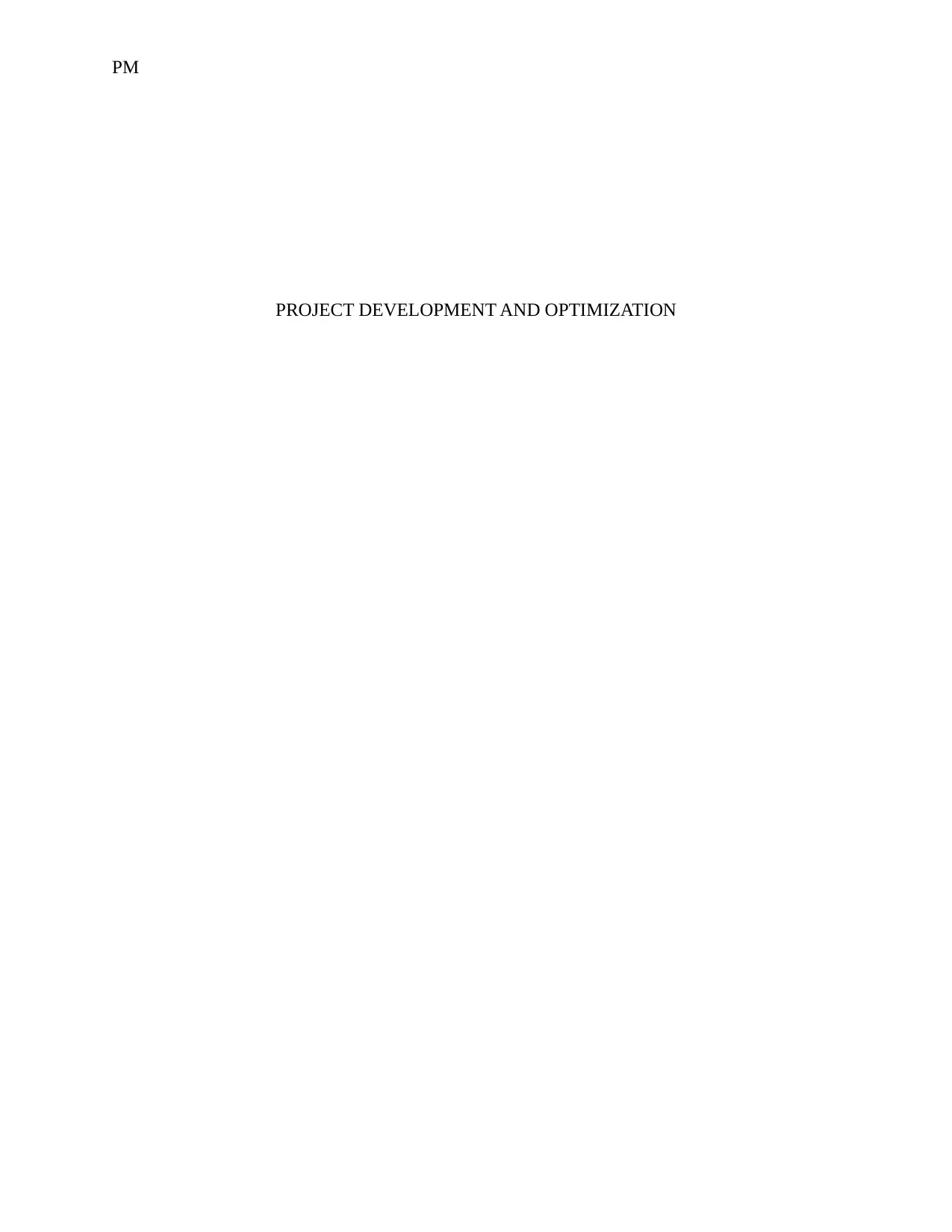
PM
PROJECT DEVELOPMENT AND OPTIMIZATION
PROJECT DEVELOPMENT AND OPTIMIZATION
Secure Best Marks with AI Grader
Need help grading? Try our AI Grader for instant feedback on your assignments.
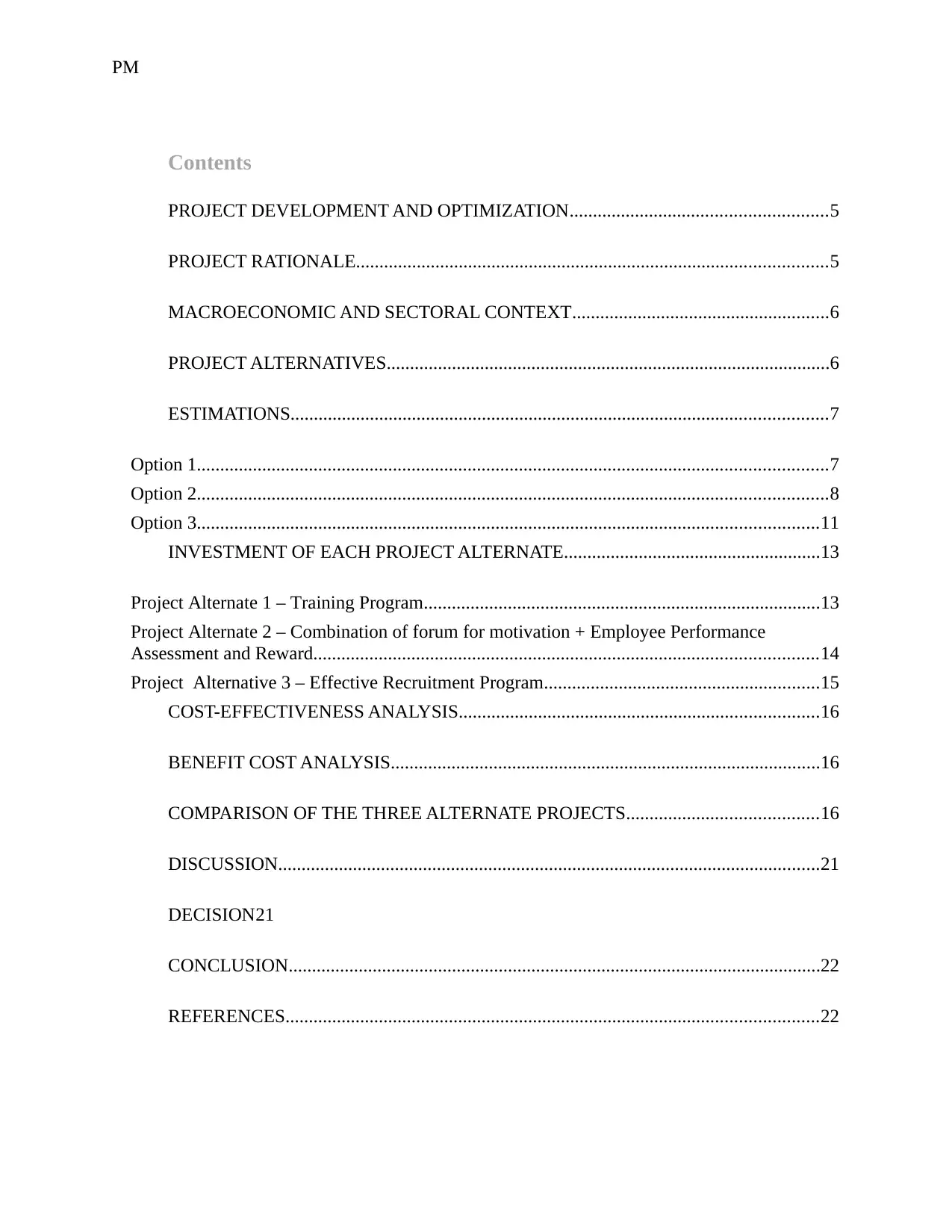
PM
Contents
PROJECT DEVELOPMENT AND OPTIMIZATION.......................................................5
PROJECT RATIONALE.....................................................................................................5
MACROECONOMIC AND SECTORAL CONTEXT.......................................................6
PROJECT ALTERNATIVES...............................................................................................6
ESTIMATIONS...................................................................................................................7
Option 1.......................................................................................................................................7
Option 2.......................................................................................................................................8
Option 3.....................................................................................................................................11
INVESTMENT OF EACH PROJECT ALTERNATE.......................................................13
Project Alternate 1 – Training Program.....................................................................................13
Project Alternate 2 – Combination of forum for motivation + Employee Performance
Assessment and Reward............................................................................................................14
Project Alternative 3 – Effective Recruitment Program...........................................................15
COST-EFFECTIVENESS ANALYSIS.............................................................................16
BENEFIT COST ANALYSIS............................................................................................16
COMPARISON OF THE THREE ALTERNATE PROJECTS.........................................16
DISCUSSION....................................................................................................................21
DECISION21
CONCLUSION..................................................................................................................22
REFERENCES..................................................................................................................22
Contents
PROJECT DEVELOPMENT AND OPTIMIZATION.......................................................5
PROJECT RATIONALE.....................................................................................................5
MACROECONOMIC AND SECTORAL CONTEXT.......................................................6
PROJECT ALTERNATIVES...............................................................................................6
ESTIMATIONS...................................................................................................................7
Option 1.......................................................................................................................................7
Option 2.......................................................................................................................................8
Option 3.....................................................................................................................................11
INVESTMENT OF EACH PROJECT ALTERNATE.......................................................13
Project Alternate 1 – Training Program.....................................................................................13
Project Alternate 2 – Combination of forum for motivation + Employee Performance
Assessment and Reward............................................................................................................14
Project Alternative 3 – Effective Recruitment Program...........................................................15
COST-EFFECTIVENESS ANALYSIS.............................................................................16
BENEFIT COST ANALYSIS............................................................................................16
COMPARISON OF THE THREE ALTERNATE PROJECTS.........................................16
DISCUSSION....................................................................................................................21
DECISION21
CONCLUSION..................................................................................................................22
REFERENCES..................................................................................................................22

PM
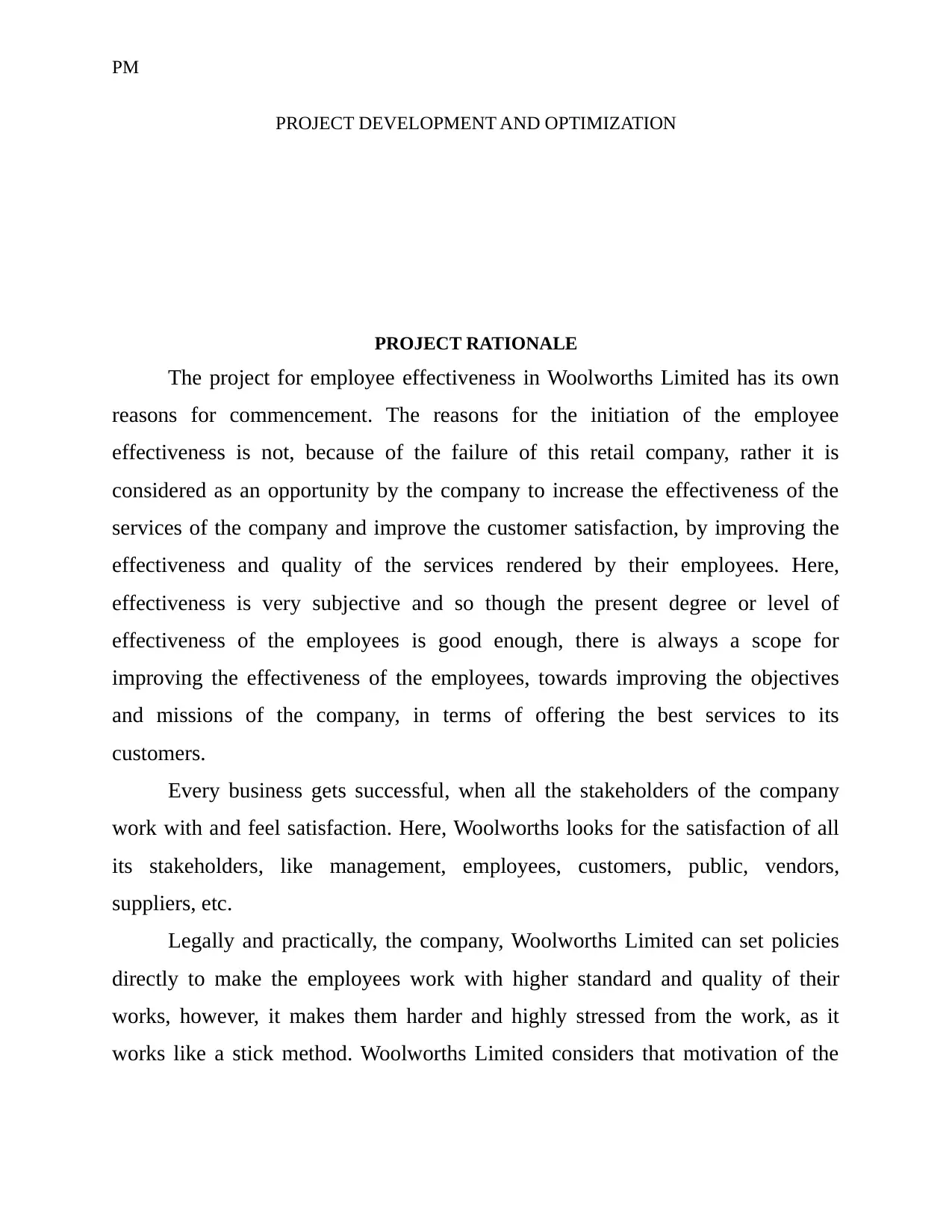
PM
PROJECT DEVELOPMENT AND OPTIMIZATION
PROJECT RATIONALE
The project for employee effectiveness in Woolworths Limited has its own
reasons for commencement. The reasons for the initiation of the employee
effectiveness is not, because of the failure of this retail company, rather it is
considered as an opportunity by the company to increase the effectiveness of the
services of the company and improve the customer satisfaction, by improving the
effectiveness and quality of the services rendered by their employees. Here,
effectiveness is very subjective and so though the present degree or level of
effectiveness of the employees is good enough, there is always a scope for
improving the effectiveness of the employees, towards improving the objectives
and missions of the company, in terms of offering the best services to its
customers.
Every business gets successful, when all the stakeholders of the company
work with and feel satisfaction. Here, Woolworths looks for the satisfaction of all
its stakeholders, like management, employees, customers, public, vendors,
suppliers, etc.
Legally and practically, the company, Woolworths Limited can set policies
directly to make the employees work with higher standard and quality of their
works, however, it makes them harder and highly stressed from the work, as it
works like a stick method. Woolworths Limited considers that motivation of the
PROJECT DEVELOPMENT AND OPTIMIZATION
PROJECT RATIONALE
The project for employee effectiveness in Woolworths Limited has its own
reasons for commencement. The reasons for the initiation of the employee
effectiveness is not, because of the failure of this retail company, rather it is
considered as an opportunity by the company to increase the effectiveness of the
services of the company and improve the customer satisfaction, by improving the
effectiveness and quality of the services rendered by their employees. Here,
effectiveness is very subjective and so though the present degree or level of
effectiveness of the employees is good enough, there is always a scope for
improving the effectiveness of the employees, towards improving the objectives
and missions of the company, in terms of offering the best services to its
customers.
Every business gets successful, when all the stakeholders of the company
work with and feel satisfaction. Here, Woolworths looks for the satisfaction of all
its stakeholders, like management, employees, customers, public, vendors,
suppliers, etc.
Legally and practically, the company, Woolworths Limited can set policies
directly to make the employees work with higher standard and quality of their
works, however, it makes them harder and highly stressed from the work, as it
works like a stick method. Woolworths Limited considers that motivation of the
Secure Best Marks with AI Grader
Need help grading? Try our AI Grader for instant feedback on your assignments.
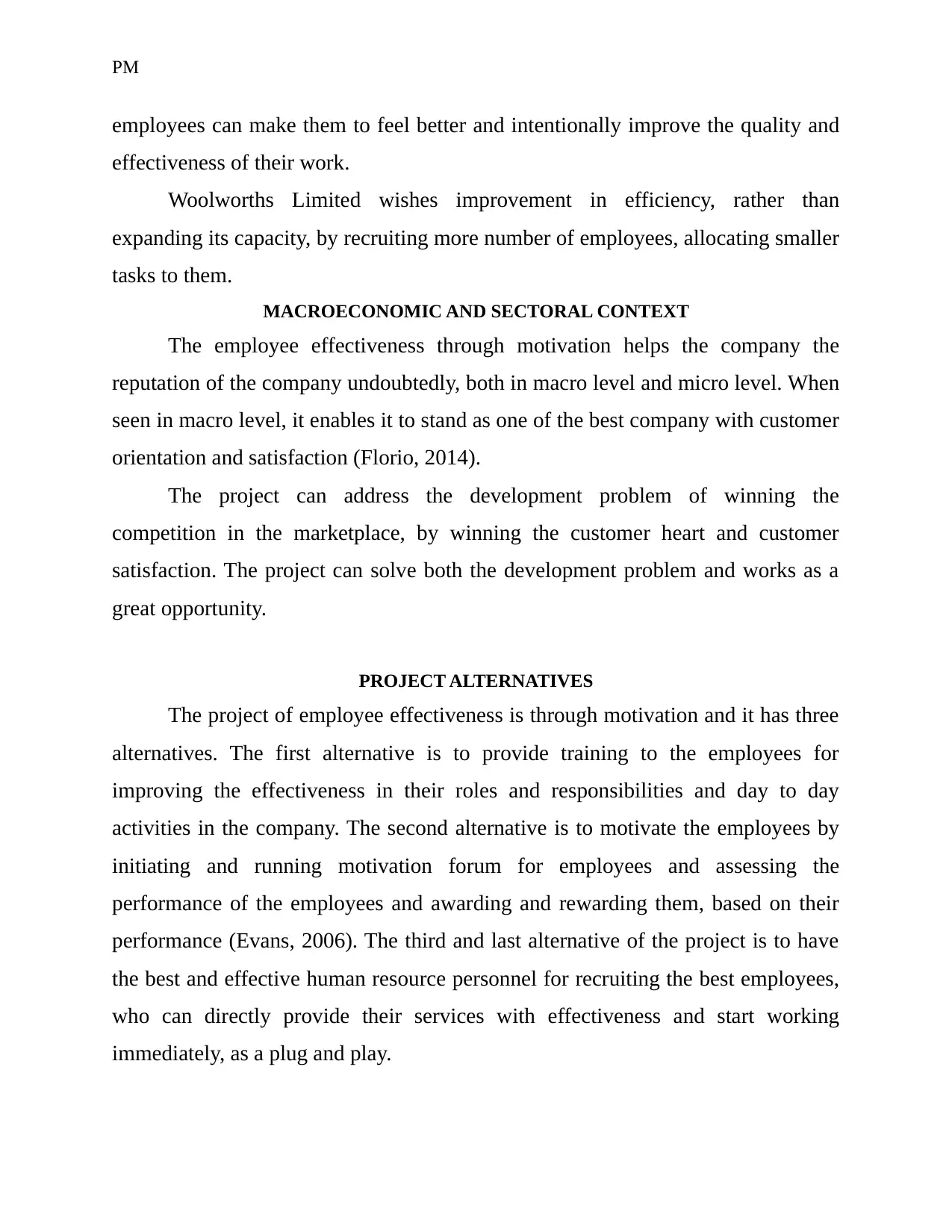
PM
employees can make them to feel better and intentionally improve the quality and
effectiveness of their work.
Woolworths Limited wishes improvement in efficiency, rather than
expanding its capacity, by recruiting more number of employees, allocating smaller
tasks to them.
MACROECONOMIC AND SECTORAL CONTEXT
The employee effectiveness through motivation helps the company the
reputation of the company undoubtedly, both in macro level and micro level. When
seen in macro level, it enables it to stand as one of the best company with customer
orientation and satisfaction (Florio, 2014).
The project can address the development problem of winning the
competition in the marketplace, by winning the customer heart and customer
satisfaction. The project can solve both the development problem and works as a
great opportunity.
PROJECT ALTERNATIVES
The project of employee effectiveness is through motivation and it has three
alternatives. The first alternative is to provide training to the employees for
improving the effectiveness in their roles and responsibilities and day to day
activities in the company. The second alternative is to motivate the employees by
initiating and running motivation forum for employees and assessing the
performance of the employees and awarding and rewarding them, based on their
performance (Evans, 2006). The third and last alternative of the project is to have
the best and effective human resource personnel for recruiting the best employees,
who can directly provide their services with effectiveness and start working
immediately, as a plug and play.
employees can make them to feel better and intentionally improve the quality and
effectiveness of their work.
Woolworths Limited wishes improvement in efficiency, rather than
expanding its capacity, by recruiting more number of employees, allocating smaller
tasks to them.
MACROECONOMIC AND SECTORAL CONTEXT
The employee effectiveness through motivation helps the company the
reputation of the company undoubtedly, both in macro level and micro level. When
seen in macro level, it enables it to stand as one of the best company with customer
orientation and satisfaction (Florio, 2014).
The project can address the development problem of winning the
competition in the marketplace, by winning the customer heart and customer
satisfaction. The project can solve both the development problem and works as a
great opportunity.
PROJECT ALTERNATIVES
The project of employee effectiveness is through motivation and it has three
alternatives. The first alternative is to provide training to the employees for
improving the effectiveness in their roles and responsibilities and day to day
activities in the company. The second alternative is to motivate the employees by
initiating and running motivation forum for employees and assessing the
performance of the employees and awarding and rewarding them, based on their
performance (Evans, 2006). The third and last alternative of the project is to have
the best and effective human resource personnel for recruiting the best employees,
who can directly provide their services with effectiveness and start working
immediately, as a plug and play.
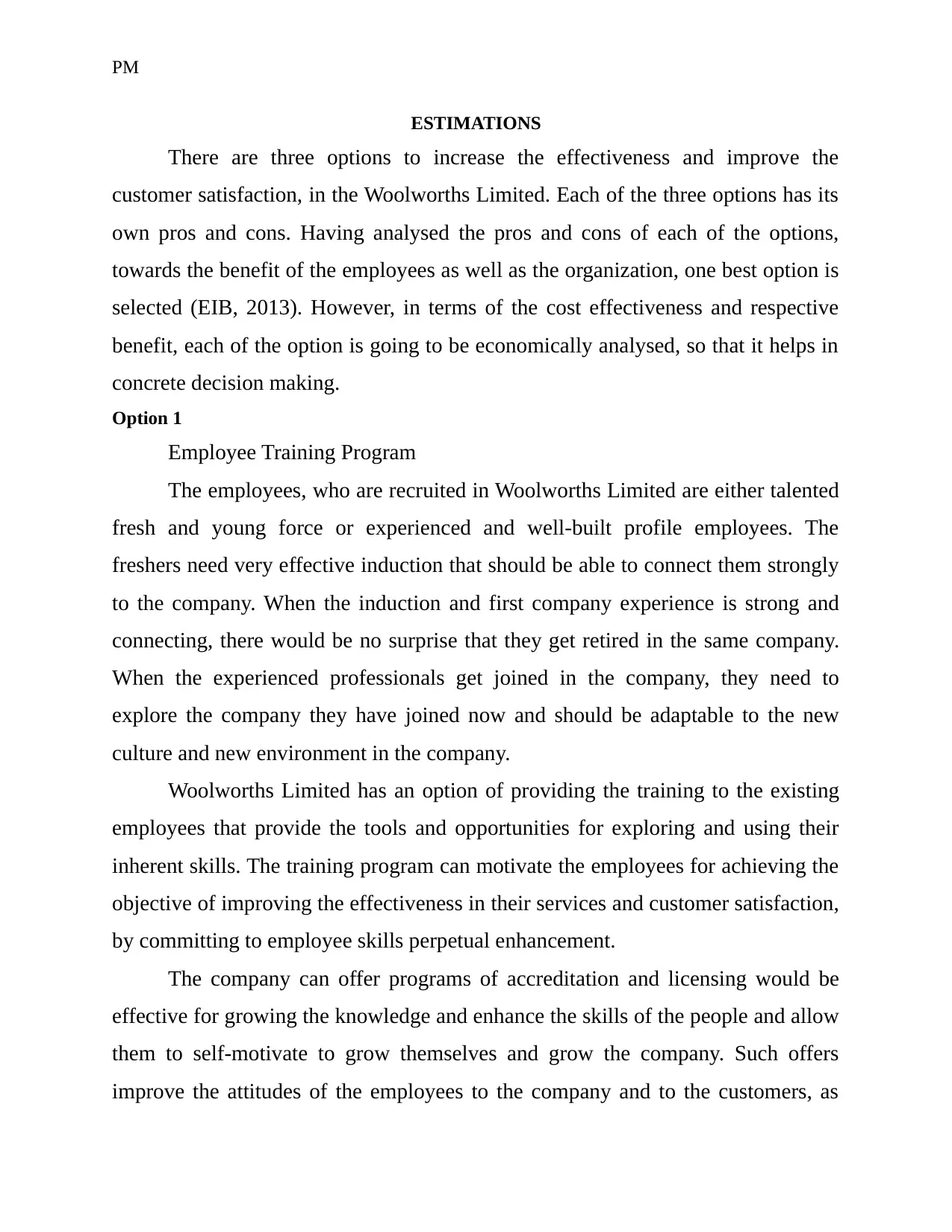
PM
ESTIMATIONS
There are three options to increase the effectiveness and improve the
customer satisfaction, in the Woolworths Limited. Each of the three options has its
own pros and cons. Having analysed the pros and cons of each of the options,
towards the benefit of the employees as well as the organization, one best option is
selected (EIB, 2013). However, in terms of the cost effectiveness and respective
benefit, each of the option is going to be economically analysed, so that it helps in
concrete decision making.
Option 1
Employee Training Program
The employees, who are recruited in Woolworths Limited are either talented
fresh and young force or experienced and well-built profile employees. The
freshers need very effective induction that should be able to connect them strongly
to the company. When the induction and first company experience is strong and
connecting, there would be no surprise that they get retired in the same company.
When the experienced professionals get joined in the company, they need to
explore the company they have joined now and should be adaptable to the new
culture and new environment in the company.
Woolworths Limited has an option of providing the training to the existing
employees that provide the tools and opportunities for exploring and using their
inherent skills. The training program can motivate the employees for achieving the
objective of improving the effectiveness in their services and customer satisfaction,
by committing to employee skills perpetual enhancement.
The company can offer programs of accreditation and licensing would be
effective for growing the knowledge and enhance the skills of the people and allow
them to self-motivate to grow themselves and grow the company. Such offers
improve the attitudes of the employees to the company and to the customers, as
ESTIMATIONS
There are three options to increase the effectiveness and improve the
customer satisfaction, in the Woolworths Limited. Each of the three options has its
own pros and cons. Having analysed the pros and cons of each of the options,
towards the benefit of the employees as well as the organization, one best option is
selected (EIB, 2013). However, in terms of the cost effectiveness and respective
benefit, each of the option is going to be economically analysed, so that it helps in
concrete decision making.
Option 1
Employee Training Program
The employees, who are recruited in Woolworths Limited are either talented
fresh and young force or experienced and well-built profile employees. The
freshers need very effective induction that should be able to connect them strongly
to the company. When the induction and first company experience is strong and
connecting, there would be no surprise that they get retired in the same company.
When the experienced professionals get joined in the company, they need to
explore the company they have joined now and should be adaptable to the new
culture and new environment in the company.
Woolworths Limited has an option of providing the training to the existing
employees that provide the tools and opportunities for exploring and using their
inherent skills. The training program can motivate the employees for achieving the
objective of improving the effectiveness in their services and customer satisfaction,
by committing to employee skills perpetual enhancement.
The company can offer programs of accreditation and licensing would be
effective for growing the knowledge and enhance the skills of the people and allow
them to self-motivate to grow themselves and grow the company. Such offers
improve the attitudes of the employees to the company and to the customers, as
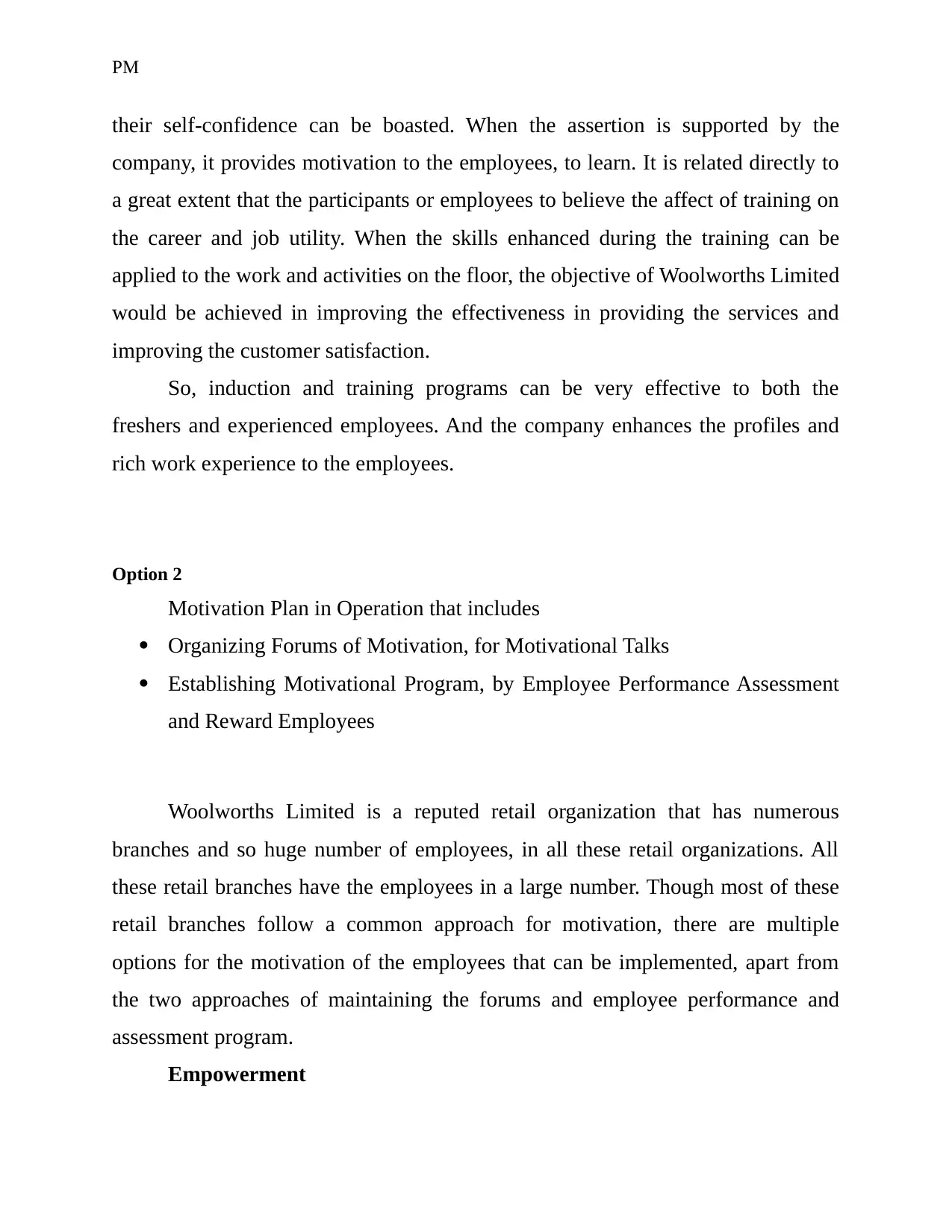
PM
their self-confidence can be boasted. When the assertion is supported by the
company, it provides motivation to the employees, to learn. It is related directly to
a great extent that the participants or employees to believe the affect of training on
the career and job utility. When the skills enhanced during the training can be
applied to the work and activities on the floor, the objective of Woolworths Limited
would be achieved in improving the effectiveness in providing the services and
improving the customer satisfaction.
So, induction and training programs can be very effective to both the
freshers and experienced employees. And the company enhances the profiles and
rich work experience to the employees.
Option 2
Motivation Plan in Operation that includes
Organizing Forums of Motivation, for Motivational Talks
Establishing Motivational Program, by Employee Performance Assessment
and Reward Employees
Woolworths Limited is a reputed retail organization that has numerous
branches and so huge number of employees, in all these retail organizations. All
these retail branches have the employees in a large number. Though most of these
retail branches follow a common approach for motivation, there are multiple
options for the motivation of the employees that can be implemented, apart from
the two approaches of maintaining the forums and employee performance and
assessment program.
Empowerment
their self-confidence can be boasted. When the assertion is supported by the
company, it provides motivation to the employees, to learn. It is related directly to
a great extent that the participants or employees to believe the affect of training on
the career and job utility. When the skills enhanced during the training can be
applied to the work and activities on the floor, the objective of Woolworths Limited
would be achieved in improving the effectiveness in providing the services and
improving the customer satisfaction.
So, induction and training programs can be very effective to both the
freshers and experienced employees. And the company enhances the profiles and
rich work experience to the employees.
Option 2
Motivation Plan in Operation that includes
Organizing Forums of Motivation, for Motivational Talks
Establishing Motivational Program, by Employee Performance Assessment
and Reward Employees
Woolworths Limited is a reputed retail organization that has numerous
branches and so huge number of employees, in all these retail organizations. All
these retail branches have the employees in a large number. Though most of these
retail branches follow a common approach for motivation, there are multiple
options for the motivation of the employees that can be implemented, apart from
the two approaches of maintaining the forums and employee performance and
assessment program.
Empowerment
Paraphrase This Document
Need a fresh take? Get an instant paraphrase of this document with our AI Paraphraser
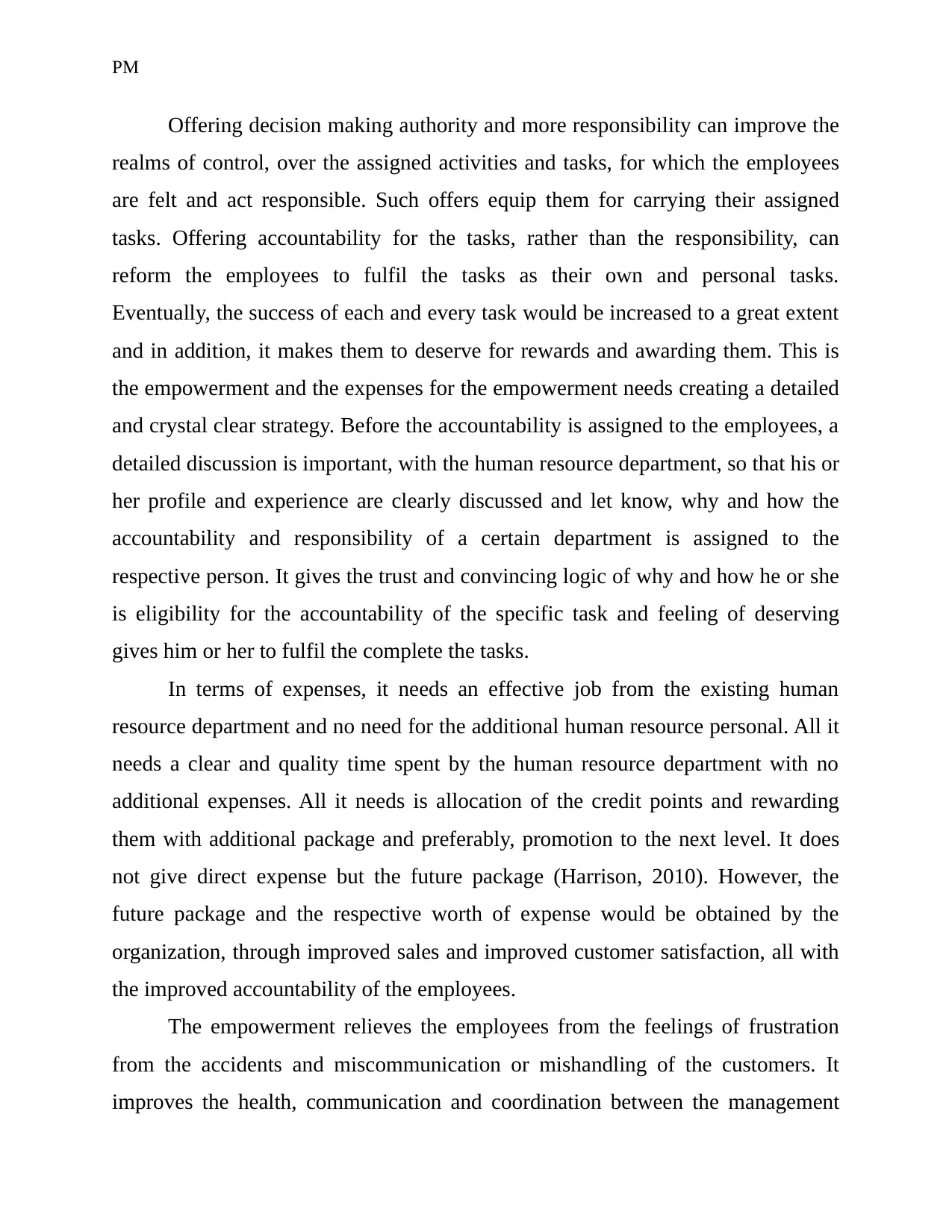
PM
Offering decision making authority and more responsibility can improve the
realms of control, over the assigned activities and tasks, for which the employees
are felt and act responsible. Such offers equip them for carrying their assigned
tasks. Offering accountability for the tasks, rather than the responsibility, can
reform the employees to fulfil the tasks as their own and personal tasks.
Eventually, the success of each and every task would be increased to a great extent
and in addition, it makes them to deserve for rewards and awarding them. This is
the empowerment and the expenses for the empowerment needs creating a detailed
and crystal clear strategy. Before the accountability is assigned to the employees, a
detailed discussion is important, with the human resource department, so that his or
her profile and experience are clearly discussed and let know, why and how the
accountability and responsibility of a certain department is assigned to the
respective person. It gives the trust and convincing logic of why and how he or she
is eligibility for the accountability of the specific task and feeling of deserving
gives him or her to fulfil the complete the tasks.
In terms of expenses, it needs an effective job from the existing human
resource department and no need for the additional human resource personal. All it
needs a clear and quality time spent by the human resource department with no
additional expenses. All it needs is allocation of the credit points and rewarding
them with additional package and preferably, promotion to the next level. It does
not give direct expense but the future package (Harrison, 2010). However, the
future package and the respective worth of expense would be obtained by the
organization, through improved sales and improved customer satisfaction, all with
the improved accountability of the employees.
The empowerment relieves the employees from the feelings of frustration
from the accidents and miscommunication or mishandling of the customers. It
improves the health, communication and coordination between the management
Offering decision making authority and more responsibility can improve the
realms of control, over the assigned activities and tasks, for which the employees
are felt and act responsible. Such offers equip them for carrying their assigned
tasks. Offering accountability for the tasks, rather than the responsibility, can
reform the employees to fulfil the tasks as their own and personal tasks.
Eventually, the success of each and every task would be increased to a great extent
and in addition, it makes them to deserve for rewards and awarding them. This is
the empowerment and the expenses for the empowerment needs creating a detailed
and crystal clear strategy. Before the accountability is assigned to the employees, a
detailed discussion is important, with the human resource department, so that his or
her profile and experience are clearly discussed and let know, why and how the
accountability and responsibility of a certain department is assigned to the
respective person. It gives the trust and convincing logic of why and how he or she
is eligibility for the accountability of the specific task and feeling of deserving
gives him or her to fulfil the complete the tasks.
In terms of expenses, it needs an effective job from the existing human
resource department and no need for the additional human resource personal. All it
needs a clear and quality time spent by the human resource department with no
additional expenses. All it needs is allocation of the credit points and rewarding
them with additional package and preferably, promotion to the next level. It does
not give direct expense but the future package (Harrison, 2010). However, the
future package and the respective worth of expense would be obtained by the
organization, through improved sales and improved customer satisfaction, all with
the improved accountability of the employees.
The empowerment relieves the employees from the feelings of frustration
from the accidents and miscommunication or mishandling of the customers. It
improves the health, communication and coordination between the management
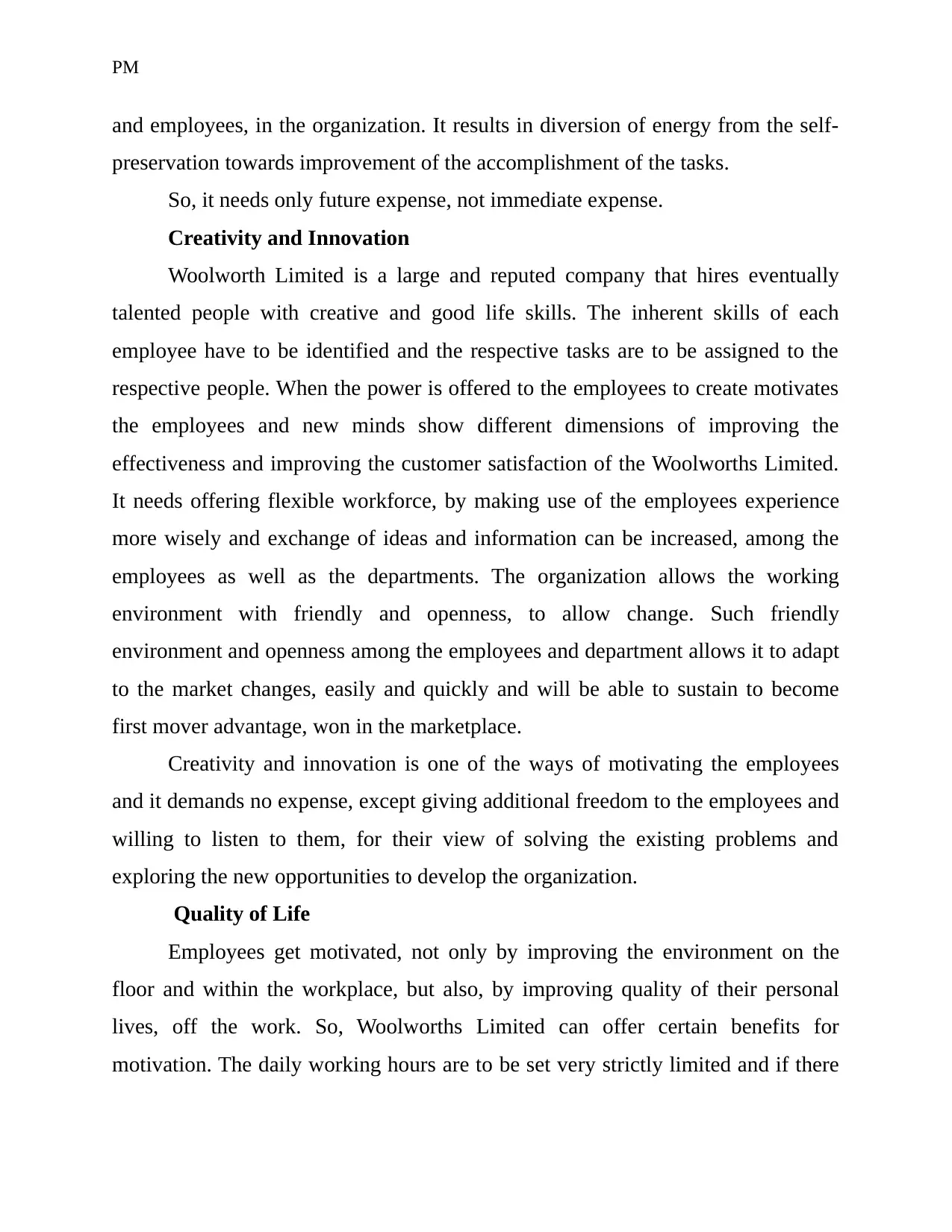
PM
and employees, in the organization. It results in diversion of energy from the self-
preservation towards improvement of the accomplishment of the tasks.
So, it needs only future expense, not immediate expense.
Creativity and Innovation
Woolworth Limited is a large and reputed company that hires eventually
talented people with creative and good life skills. The inherent skills of each
employee have to be identified and the respective tasks are to be assigned to the
respective people. When the power is offered to the employees to create motivates
the employees and new minds show different dimensions of improving the
effectiveness and improving the customer satisfaction of the Woolworths Limited.
It needs offering flexible workforce, by making use of the employees experience
more wisely and exchange of ideas and information can be increased, among the
employees as well as the departments. The organization allows the working
environment with friendly and openness, to allow change. Such friendly
environment and openness among the employees and department allows it to adapt
to the market changes, easily and quickly and will be able to sustain to become
first mover advantage, won in the marketplace.
Creativity and innovation is one of the ways of motivating the employees
and it demands no expense, except giving additional freedom to the employees and
willing to listen to them, for their view of solving the existing problems and
exploring the new opportunities to develop the organization.
Quality of Life
Employees get motivated, not only by improving the environment on the
floor and within the workplace, but also, by improving quality of their personal
lives, off the work. So, Woolworths Limited can offer certain benefits for
motivation. The daily working hours are to be set very strictly limited and if there
and employees, in the organization. It results in diversion of energy from the self-
preservation towards improvement of the accomplishment of the tasks.
So, it needs only future expense, not immediate expense.
Creativity and Innovation
Woolworth Limited is a large and reputed company that hires eventually
talented people with creative and good life skills. The inherent skills of each
employee have to be identified and the respective tasks are to be assigned to the
respective people. When the power is offered to the employees to create motivates
the employees and new minds show different dimensions of improving the
effectiveness and improving the customer satisfaction of the Woolworths Limited.
It needs offering flexible workforce, by making use of the employees experience
more wisely and exchange of ideas and information can be increased, among the
employees as well as the departments. The organization allows the working
environment with friendly and openness, to allow change. Such friendly
environment and openness among the employees and department allows it to adapt
to the market changes, easily and quickly and will be able to sustain to become
first mover advantage, won in the marketplace.
Creativity and innovation is one of the ways of motivating the employees
and it demands no expense, except giving additional freedom to the employees and
willing to listen to them, for their view of solving the existing problems and
exploring the new opportunities to develop the organization.
Quality of Life
Employees get motivated, not only by improving the environment on the
floor and within the workplace, but also, by improving quality of their personal
lives, off the work. So, Woolworths Limited can offer certain benefits for
motivation. The daily working hours are to be set very strictly limited and if there
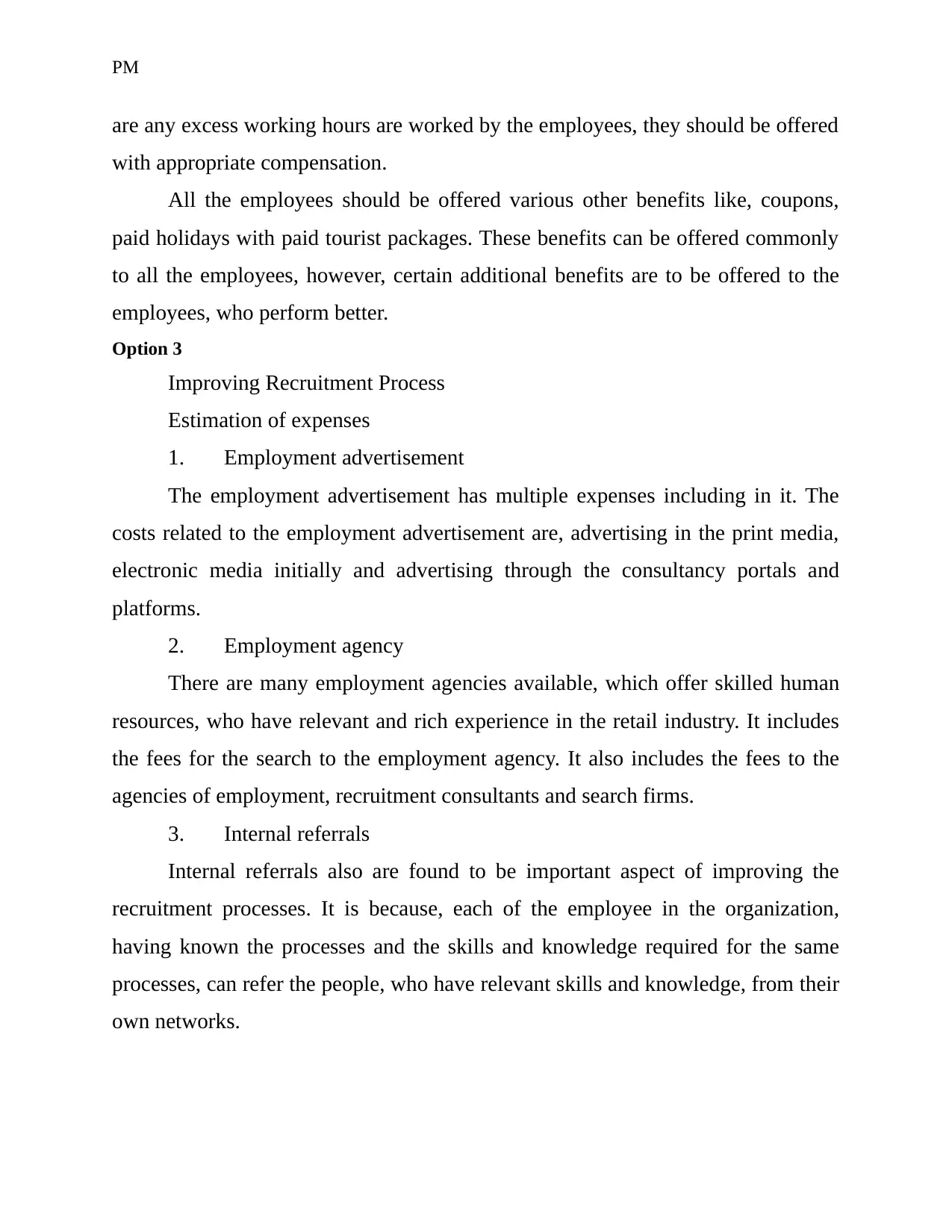
PM
are any excess working hours are worked by the employees, they should be offered
with appropriate compensation.
All the employees should be offered various other benefits like, coupons,
paid holidays with paid tourist packages. These benefits can be offered commonly
to all the employees, however, certain additional benefits are to be offered to the
employees, who perform better.
Option 3
Improving Recruitment Process
Estimation of expenses
1. Employment advertisement
The employment advertisement has multiple expenses including in it. The
costs related to the employment advertisement are, advertising in the print media,
electronic media initially and advertising through the consultancy portals and
platforms.
2. Employment agency
There are many employment agencies available, which offer skilled human
resources, who have relevant and rich experience in the retail industry. It includes
the fees for the search to the employment agency. It also includes the fees to the
agencies of employment, recruitment consultants and search firms.
3. Internal referrals
Internal referrals also are found to be important aspect of improving the
recruitment processes. It is because, each of the employee in the organization,
having known the processes and the skills and knowledge required for the same
processes, can refer the people, who have relevant skills and knowledge, from their
own networks.
are any excess working hours are worked by the employees, they should be offered
with appropriate compensation.
All the employees should be offered various other benefits like, coupons,
paid holidays with paid tourist packages. These benefits can be offered commonly
to all the employees, however, certain additional benefits are to be offered to the
employees, who perform better.
Option 3
Improving Recruitment Process
Estimation of expenses
1. Employment advertisement
The employment advertisement has multiple expenses including in it. The
costs related to the employment advertisement are, advertising in the print media,
electronic media initially and advertising through the consultancy portals and
platforms.
2. Employment agency
There are many employment agencies available, which offer skilled human
resources, who have relevant and rich experience in the retail industry. It includes
the fees for the search to the employment agency. It also includes the fees to the
agencies of employment, recruitment consultants and search firms.
3. Internal referrals
Internal referrals also are found to be important aspect of improving the
recruitment processes. It is because, each of the employee in the organization,
having known the processes and the skills and knowledge required for the same
processes, can refer the people, who have relevant skills and knowledge, from their
own networks.
Secure Best Marks with AI Grader
Need help grading? Try our AI Grader for instant feedback on your assignments.
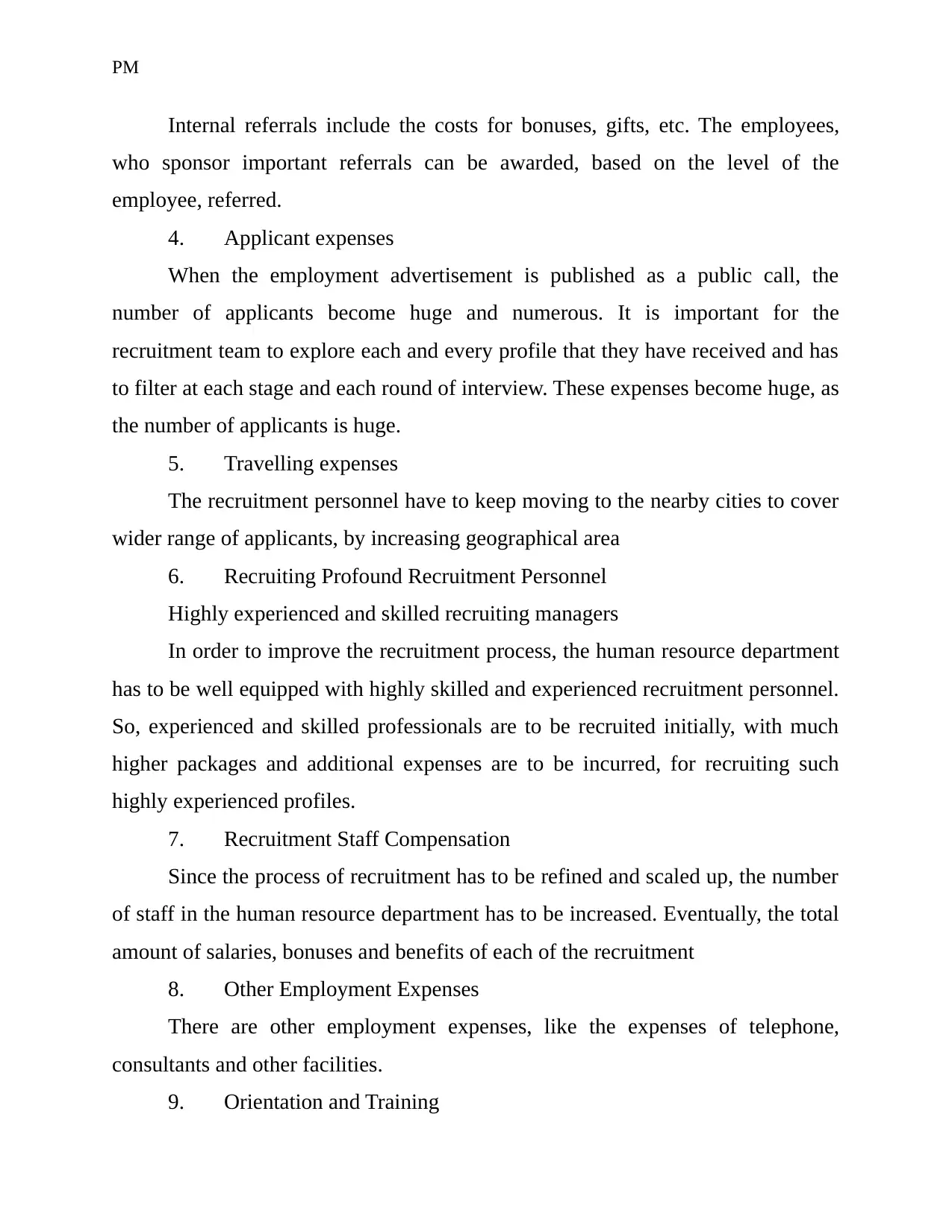
PM
Internal referrals include the costs for bonuses, gifts, etc. The employees,
who sponsor important referrals can be awarded, based on the level of the
employee, referred.
4. Applicant expenses
When the employment advertisement is published as a public call, the
number of applicants become huge and numerous. It is important for the
recruitment team to explore each and every profile that they have received and has
to filter at each stage and each round of interview. These expenses become huge, as
the number of applicants is huge.
5. Travelling expenses
The recruitment personnel have to keep moving to the nearby cities to cover
wider range of applicants, by increasing geographical area
6. Recruiting Profound Recruitment Personnel
Highly experienced and skilled recruiting managers
In order to improve the recruitment process, the human resource department
has to be well equipped with highly skilled and experienced recruitment personnel.
So, experienced and skilled professionals are to be recruited initially, with much
higher packages and additional expenses are to be incurred, for recruiting such
highly experienced profiles.
7. Recruitment Staff Compensation
Since the process of recruitment has to be refined and scaled up, the number
of staff in the human resource department has to be increased. Eventually, the total
amount of salaries, bonuses and benefits of each of the recruitment
8. Other Employment Expenses
There are other employment expenses, like the expenses of telephone,
consultants and other facilities.
9. Orientation and Training
Internal referrals include the costs for bonuses, gifts, etc. The employees,
who sponsor important referrals can be awarded, based on the level of the
employee, referred.
4. Applicant expenses
When the employment advertisement is published as a public call, the
number of applicants become huge and numerous. It is important for the
recruitment team to explore each and every profile that they have received and has
to filter at each stage and each round of interview. These expenses become huge, as
the number of applicants is huge.
5. Travelling expenses
The recruitment personnel have to keep moving to the nearby cities to cover
wider range of applicants, by increasing geographical area
6. Recruiting Profound Recruitment Personnel
Highly experienced and skilled recruiting managers
In order to improve the recruitment process, the human resource department
has to be well equipped with highly skilled and experienced recruitment personnel.
So, experienced and skilled professionals are to be recruited initially, with much
higher packages and additional expenses are to be incurred, for recruiting such
highly experienced profiles.
7. Recruitment Staff Compensation
Since the process of recruitment has to be refined and scaled up, the number
of staff in the human resource department has to be increased. Eventually, the total
amount of salaries, bonuses and benefits of each of the recruitment
8. Other Employment Expenses
There are other employment expenses, like the expenses of telephone,
consultants and other facilities.
9. Orientation and Training
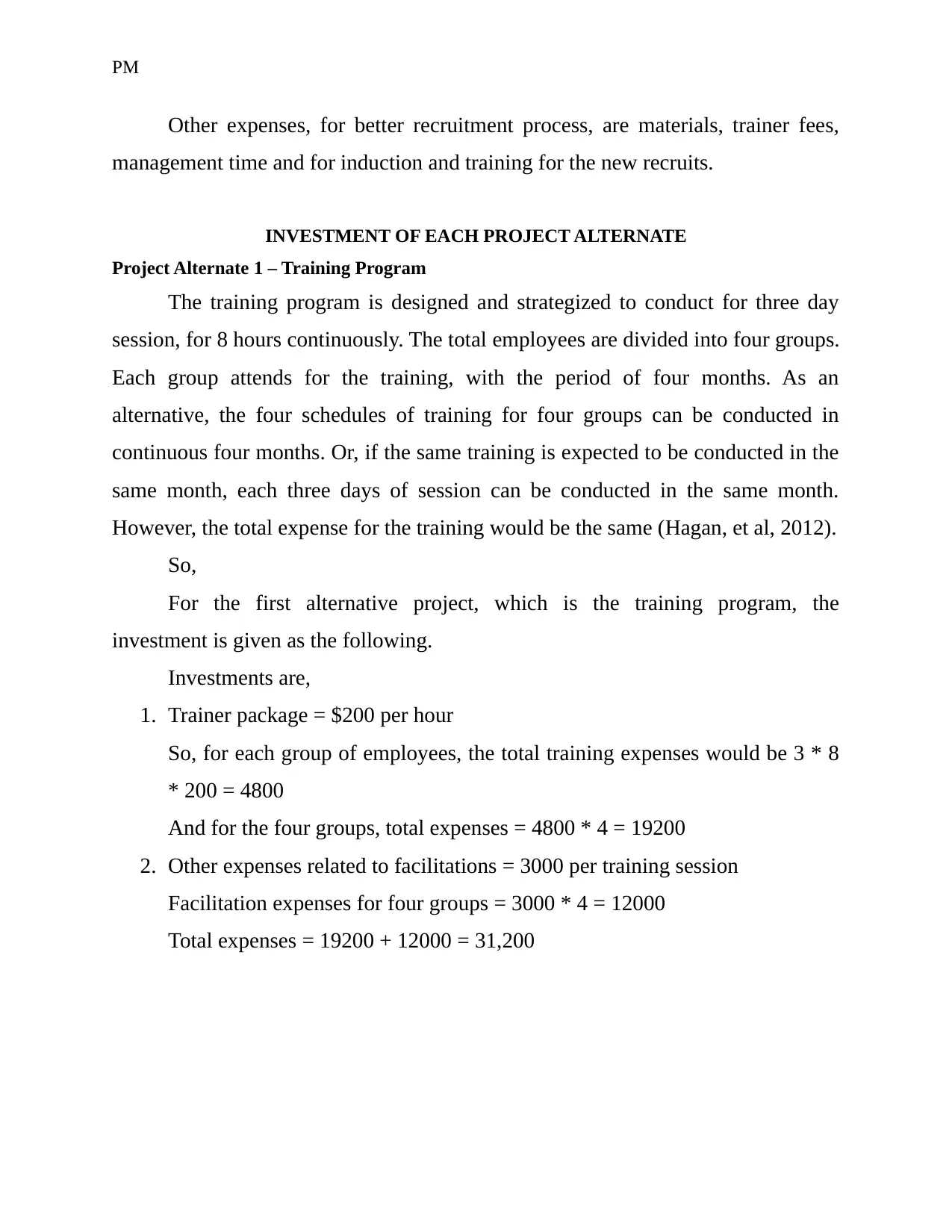
PM
Other expenses, for better recruitment process, are materials, trainer fees,
management time and for induction and training for the new recruits.
INVESTMENT OF EACH PROJECT ALTERNATE
Project Alternate 1 – Training Program
The training program is designed and strategized to conduct for three day
session, for 8 hours continuously. The total employees are divided into four groups.
Each group attends for the training, with the period of four months. As an
alternative, the four schedules of training for four groups can be conducted in
continuous four months. Or, if the same training is expected to be conducted in the
same month, each three days of session can be conducted in the same month.
However, the total expense for the training would be the same (Hagan, et al, 2012).
So,
For the first alternative project, which is the training program, the
investment is given as the following.
Investments are,
1. Trainer package = $200 per hour
So, for each group of employees, the total training expenses would be 3 * 8
* 200 = 4800
And for the four groups, total expenses = 4800 * 4 = 19200
2. Other expenses related to facilitations = 3000 per training session
Facilitation expenses for four groups = 3000 * 4 = 12000
Total expenses = 19200 + 12000 = 31,200
Other expenses, for better recruitment process, are materials, trainer fees,
management time and for induction and training for the new recruits.
INVESTMENT OF EACH PROJECT ALTERNATE
Project Alternate 1 – Training Program
The training program is designed and strategized to conduct for three day
session, for 8 hours continuously. The total employees are divided into four groups.
Each group attends for the training, with the period of four months. As an
alternative, the four schedules of training for four groups can be conducted in
continuous four months. Or, if the same training is expected to be conducted in the
same month, each three days of session can be conducted in the same month.
However, the total expense for the training would be the same (Hagan, et al, 2012).
So,
For the first alternative project, which is the training program, the
investment is given as the following.
Investments are,
1. Trainer package = $200 per hour
So, for each group of employees, the total training expenses would be 3 * 8
* 200 = 4800
And for the four groups, total expenses = 4800 * 4 = 19200
2. Other expenses related to facilitations = 3000 per training session
Facilitation expenses for four groups = 3000 * 4 = 12000
Total expenses = 19200 + 12000 = 31,200
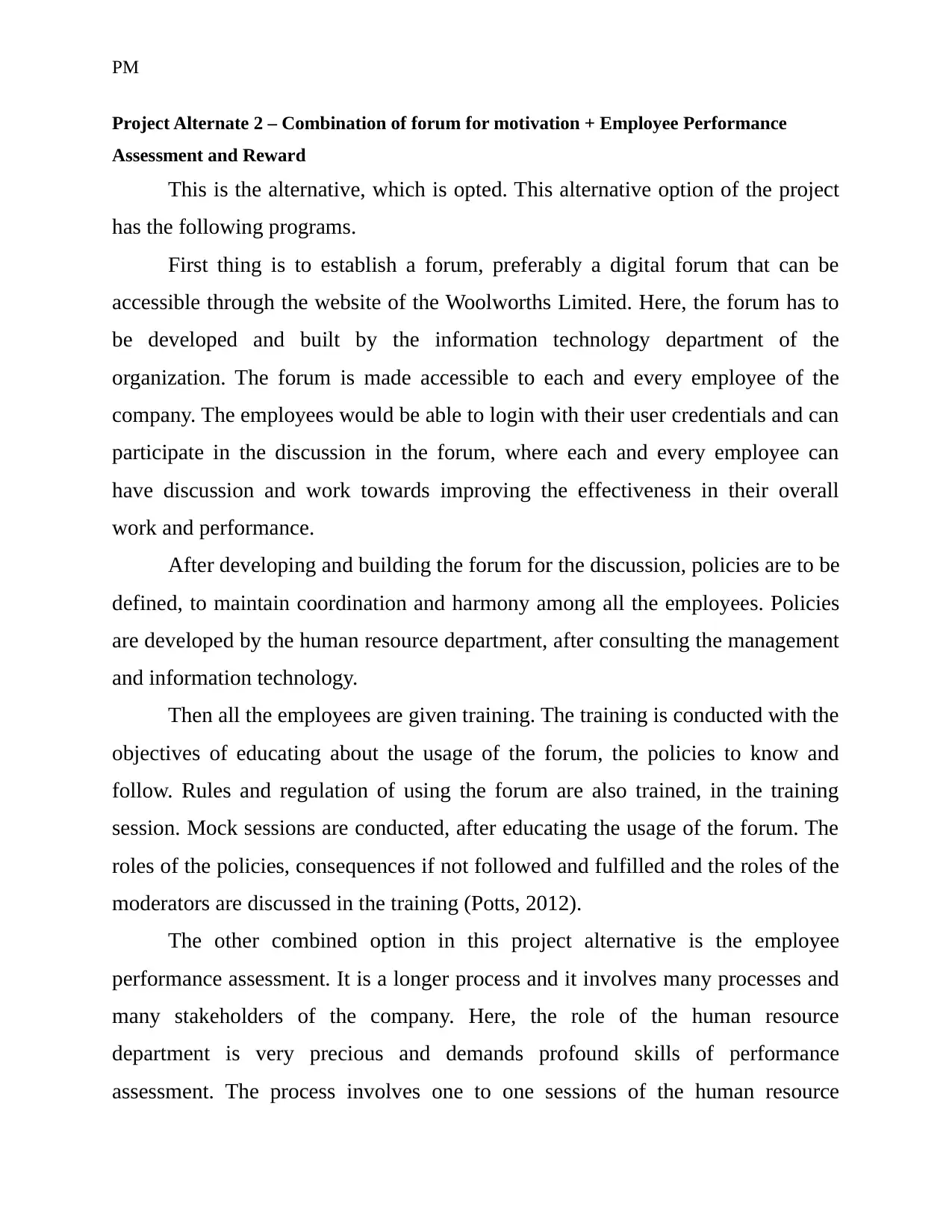
PM
Project Alternate 2 – Combination of forum for motivation + Employee Performance
Assessment and Reward
This is the alternative, which is opted. This alternative option of the project
has the following programs.
First thing is to establish a forum, preferably a digital forum that can be
accessible through the website of the Woolworths Limited. Here, the forum has to
be developed and built by the information technology department of the
organization. The forum is made accessible to each and every employee of the
company. The employees would be able to login with their user credentials and can
participate in the discussion in the forum, where each and every employee can
have discussion and work towards improving the effectiveness in their overall
work and performance.
After developing and building the forum for the discussion, policies are to be
defined, to maintain coordination and harmony among all the employees. Policies
are developed by the human resource department, after consulting the management
and information technology.
Then all the employees are given training. The training is conducted with the
objectives of educating about the usage of the forum, the policies to know and
follow. Rules and regulation of using the forum are also trained, in the training
session. Mock sessions are conducted, after educating the usage of the forum. The
roles of the policies, consequences if not followed and fulfilled and the roles of the
moderators are discussed in the training (Potts, 2012).
The other combined option in this project alternative is the employee
performance assessment. It is a longer process and it involves many processes and
many stakeholders of the company. Here, the role of the human resource
department is very precious and demands profound skills of performance
assessment. The process involves one to one sessions of the human resource
Project Alternate 2 – Combination of forum for motivation + Employee Performance
Assessment and Reward
This is the alternative, which is opted. This alternative option of the project
has the following programs.
First thing is to establish a forum, preferably a digital forum that can be
accessible through the website of the Woolworths Limited. Here, the forum has to
be developed and built by the information technology department of the
organization. The forum is made accessible to each and every employee of the
company. The employees would be able to login with their user credentials and can
participate in the discussion in the forum, where each and every employee can
have discussion and work towards improving the effectiveness in their overall
work and performance.
After developing and building the forum for the discussion, policies are to be
defined, to maintain coordination and harmony among all the employees. Policies
are developed by the human resource department, after consulting the management
and information technology.
Then all the employees are given training. The training is conducted with the
objectives of educating about the usage of the forum, the policies to know and
follow. Rules and regulation of using the forum are also trained, in the training
session. Mock sessions are conducted, after educating the usage of the forum. The
roles of the policies, consequences if not followed and fulfilled and the roles of the
moderators are discussed in the training (Potts, 2012).
The other combined option in this project alternative is the employee
performance assessment. It is a longer process and it involves many processes and
many stakeholders of the company. Here, the role of the human resource
department is very precious and demands profound skills of performance
assessment. The process involves one to one sessions of the human resource
Paraphrase This Document
Need a fresh take? Get an instant paraphrase of this document with our AI Paraphraser
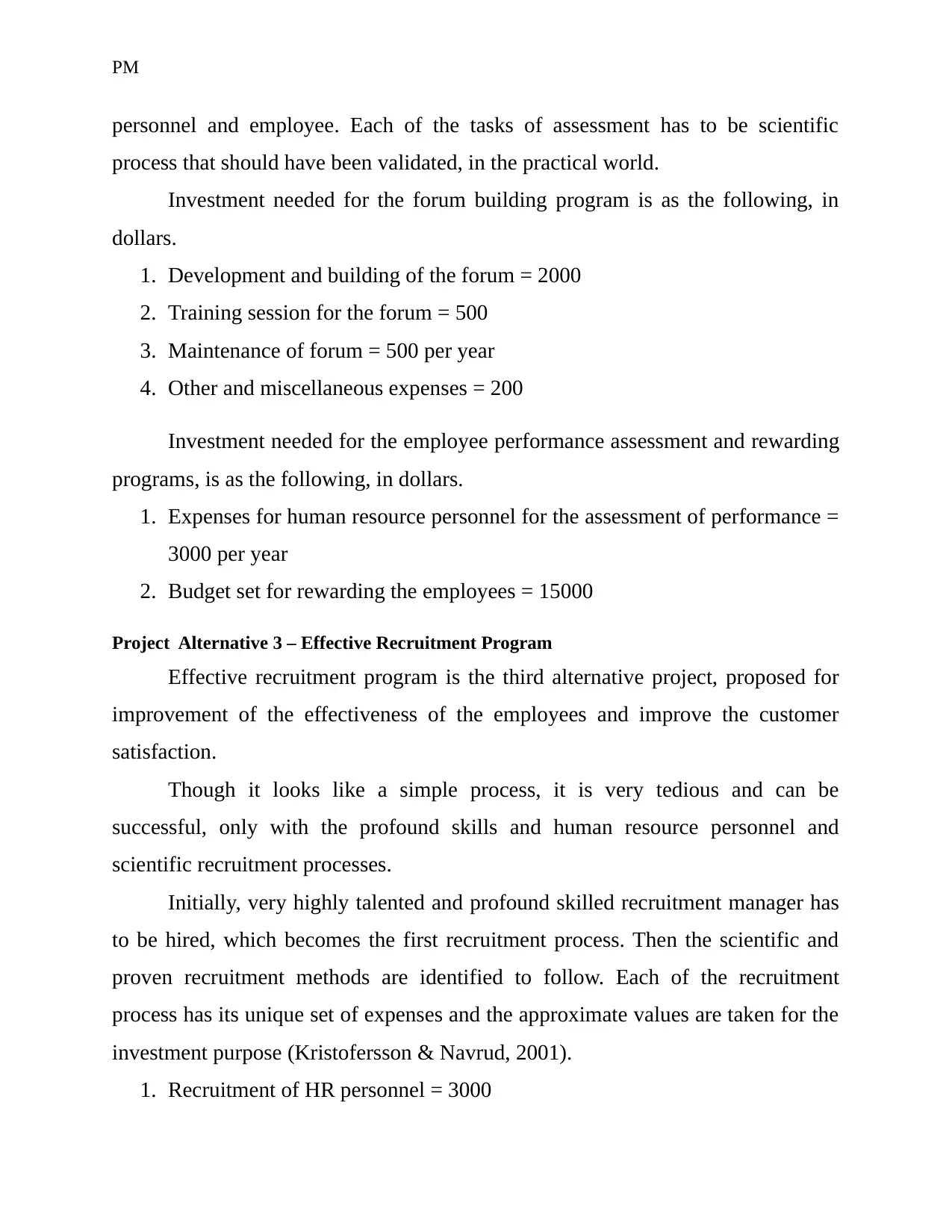
PM
personnel and employee. Each of the tasks of assessment has to be scientific
process that should have been validated, in the practical world.
Investment needed for the forum building program is as the following, in
dollars.
1. Development and building of the forum = 2000
2. Training session for the forum = 500
3. Maintenance of forum = 500 per year
4. Other and miscellaneous expenses = 200
Investment needed for the employee performance assessment and rewarding
programs, is as the following, in dollars.
1. Expenses for human resource personnel for the assessment of performance =
3000 per year
2. Budget set for rewarding the employees = 15000
Project Alternative 3 – Effective Recruitment Program
Effective recruitment program is the third alternative project, proposed for
improvement of the effectiveness of the employees and improve the customer
satisfaction.
Though it looks like a simple process, it is very tedious and can be
successful, only with the profound skills and human resource personnel and
scientific recruitment processes.
Initially, very highly talented and profound skilled recruitment manager has
to be hired, which becomes the first recruitment process. Then the scientific and
proven recruitment methods are identified to follow. Each of the recruitment
process has its unique set of expenses and the approximate values are taken for the
investment purpose (Kristofersson & Navrud, 2001).
1. Recruitment of HR personnel = 3000
personnel and employee. Each of the tasks of assessment has to be scientific
process that should have been validated, in the practical world.
Investment needed for the forum building program is as the following, in
dollars.
1. Development and building of the forum = 2000
2. Training session for the forum = 500
3. Maintenance of forum = 500 per year
4. Other and miscellaneous expenses = 200
Investment needed for the employee performance assessment and rewarding
programs, is as the following, in dollars.
1. Expenses for human resource personnel for the assessment of performance =
3000 per year
2. Budget set for rewarding the employees = 15000
Project Alternative 3 – Effective Recruitment Program
Effective recruitment program is the third alternative project, proposed for
improvement of the effectiveness of the employees and improve the customer
satisfaction.
Though it looks like a simple process, it is very tedious and can be
successful, only with the profound skills and human resource personnel and
scientific recruitment processes.
Initially, very highly talented and profound skilled recruitment manager has
to be hired, which becomes the first recruitment process. Then the scientific and
proven recruitment methods are identified to follow. Each of the recruitment
process has its unique set of expenses and the approximate values are taken for the
investment purpose (Kristofersson & Navrud, 2001).
1. Recruitment of HR personnel = 3000
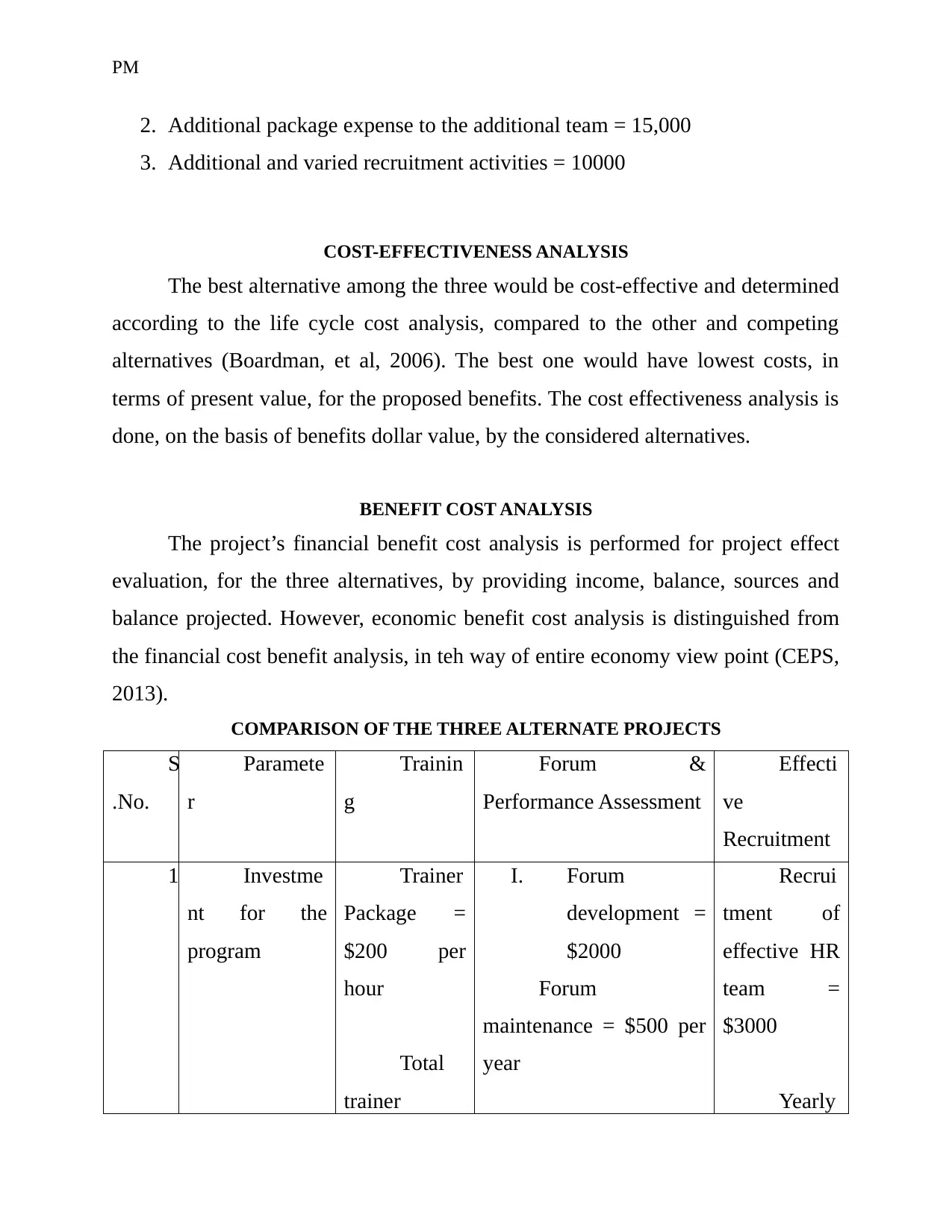
PM
2. Additional package expense to the additional team = 15,000
3. Additional and varied recruitment activities = 10000
COST-EFFECTIVENESS ANALYSIS
The best alternative among the three would be cost-effective and determined
according to the life cycle cost analysis, compared to the other and competing
alternatives (Boardman, et al, 2006). The best one would have lowest costs, in
terms of present value, for the proposed benefits. The cost effectiveness analysis is
done, on the basis of benefits dollar value, by the considered alternatives.
BENEFIT COST ANALYSIS
The project’s financial benefit cost analysis is performed for project effect
evaluation, for the three alternatives, by providing income, balance, sources and
balance projected. However, economic benefit cost analysis is distinguished from
the financial cost benefit analysis, in teh way of entire economy view point (CEPS,
2013).
COMPARISON OF THE THREE ALTERNATE PROJECTS
S
.No.
Paramete
r
Trainin
g
Forum &
Performance Assessment
Effecti
ve
Recruitment
1 Investme
nt for the
program
Trainer
Package =
$200 per
hour
Total
trainer
I. Forum
development =
$2000
Forum
maintenance = $500 per
year
Recrui
tment of
effective HR
team =
$3000
Yearly
2. Additional package expense to the additional team = 15,000
3. Additional and varied recruitment activities = 10000
COST-EFFECTIVENESS ANALYSIS
The best alternative among the three would be cost-effective and determined
according to the life cycle cost analysis, compared to the other and competing
alternatives (Boardman, et al, 2006). The best one would have lowest costs, in
terms of present value, for the proposed benefits. The cost effectiveness analysis is
done, on the basis of benefits dollar value, by the considered alternatives.
BENEFIT COST ANALYSIS
The project’s financial benefit cost analysis is performed for project effect
evaluation, for the three alternatives, by providing income, balance, sources and
balance projected. However, economic benefit cost analysis is distinguished from
the financial cost benefit analysis, in teh way of entire economy view point (CEPS,
2013).
COMPARISON OF THE THREE ALTERNATE PROJECTS
S
.No.
Paramete
r
Trainin
g
Forum &
Performance Assessment
Effecti
ve
Recruitment
1 Investme
nt for the
program
Trainer
Package =
$200 per
hour
Total
trainer
I. Forum
development =
$2000
Forum
maintenance = $500 per
year
Recrui
tment of
effective HR
team =
$3000
Yearly
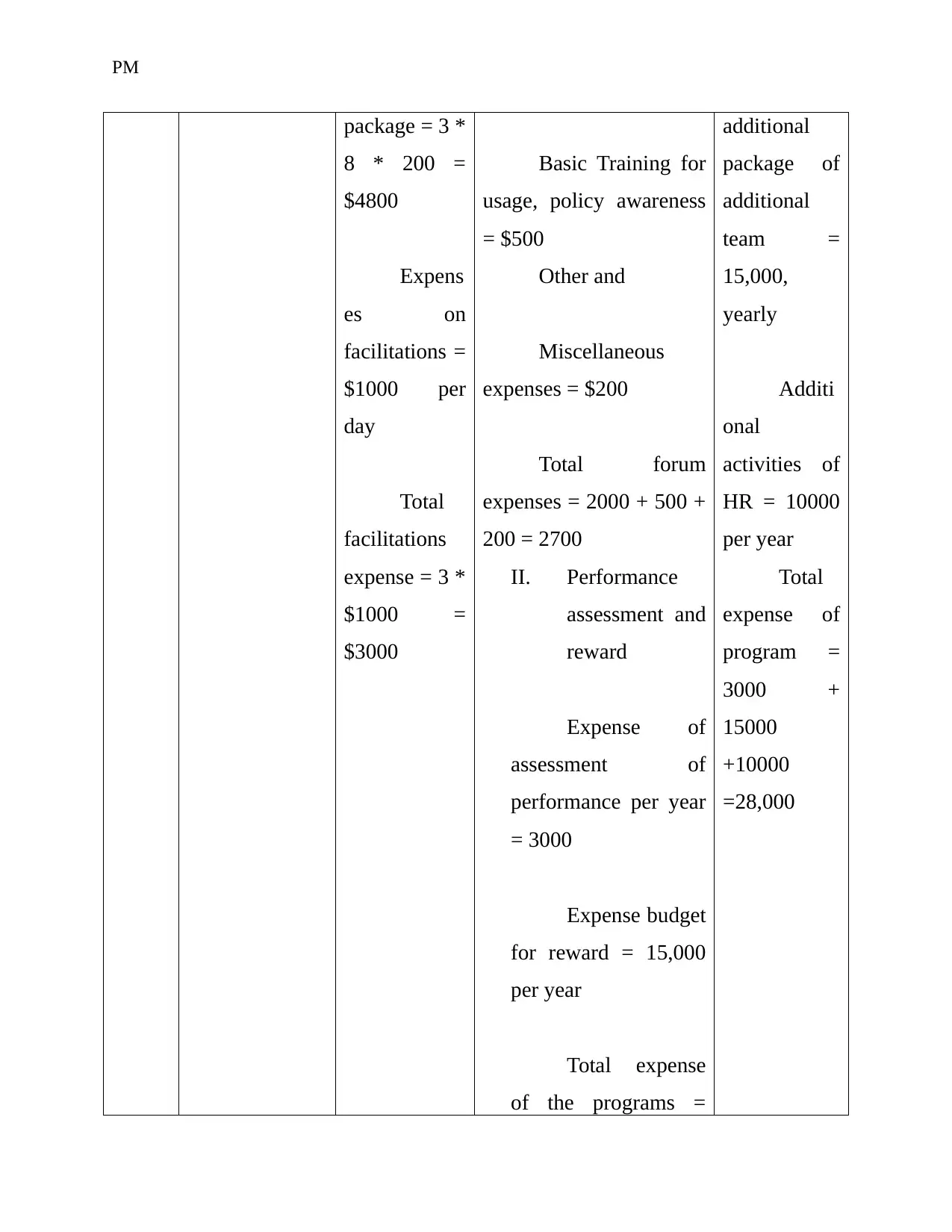
PM
package = 3 *
8 * 200 =
$4800
Expens
es on
facilitations =
$1000 per
day
Total
facilitations
expense = 3 *
$1000 =
$3000
Basic Training for
usage, policy awareness
= $500
Other and
Miscellaneous
expenses = $200
Total forum
expenses = 2000 + 500 +
200 = 2700
II. Performance
assessment and
reward
Expense of
assessment of
performance per year
= 3000
Expense budget
for reward = 15,000
per year
Total expense
of the programs =
additional
package of
additional
team =
15,000,
yearly
Additi
onal
activities of
HR = 10000
per year
Total
expense of
program =
3000 +
15000
+10000
=28,000
package = 3 *
8 * 200 =
$4800
Expens
es on
facilitations =
$1000 per
day
Total
facilitations
expense = 3 *
$1000 =
$3000
Basic Training for
usage, policy awareness
= $500
Other and
Miscellaneous
expenses = $200
Total forum
expenses = 2000 + 500 +
200 = 2700
II. Performance
assessment and
reward
Expense of
assessment of
performance per year
= 3000
Expense budget
for reward = 15,000
per year
Total expense
of the programs =
additional
package of
additional
team =
15,000,
yearly
Additi
onal
activities of
HR = 10000
per year
Total
expense of
program =
3000 +
15000
+10000
=28,000
Secure Best Marks with AI Grader
Need help grading? Try our AI Grader for instant feedback on your assignments.
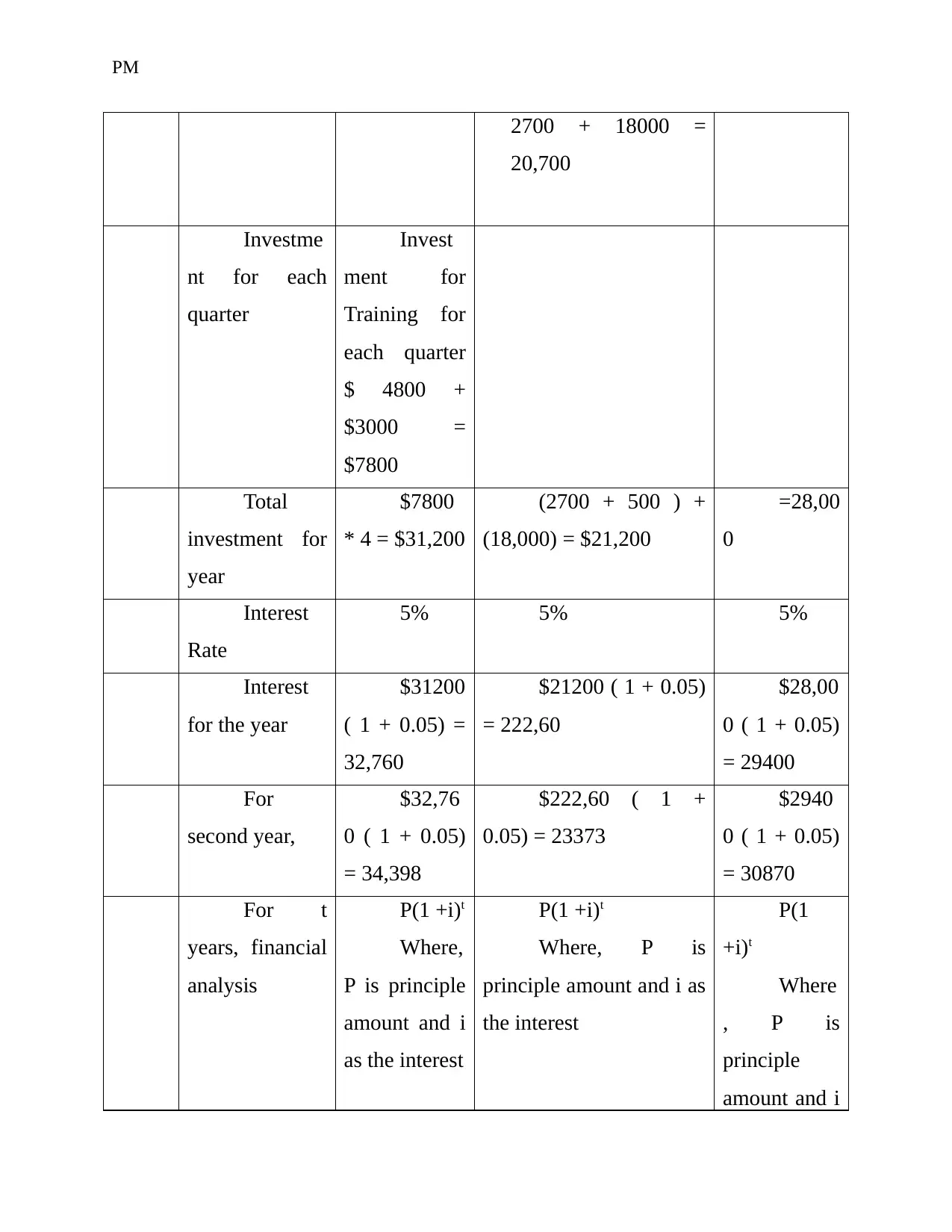
PM
2700 + 18000 =
20,700
Investme
nt for each
quarter
Invest
ment for
Training for
each quarter
$ 4800 +
$3000 =
$7800
Total
investment for
year
$7800
* 4 = $31,200
(2700 + 500 ) +
(18,000) = $21,200
=28,00
0
Interest
Rate
5% 5% 5%
Interest
for the year
$31200
( 1 + 0.05) =
32,760
$21200 ( 1 + 0.05)
= 222,60
$28,00
0 ( 1 + 0.05)
= 29400
For
second year,
$32,76
0 ( 1 + 0.05)
= 34,398
$222,60 ( 1 +
0.05) = 23373
$2940
0 ( 1 + 0.05)
= 30870
For t
years, financial
analysis
P(1 +i)t
Where,
P is principle
amount and i
as the interest
P(1 +i)t
Where, P is
principle amount and i as
the interest
P(1
+i)t
Where
, P is
principle
amount and i
2700 + 18000 =
20,700
Investme
nt for each
quarter
Invest
ment for
Training for
each quarter
$ 4800 +
$3000 =
$7800
Total
investment for
year
$7800
* 4 = $31,200
(2700 + 500 ) +
(18,000) = $21,200
=28,00
0
Interest
Rate
5% 5% 5%
Interest
for the year
$31200
( 1 + 0.05) =
32,760
$21200 ( 1 + 0.05)
= 222,60
$28,00
0 ( 1 + 0.05)
= 29400
For
second year,
$32,76
0 ( 1 + 0.05)
= 34,398
$222,60 ( 1 +
0.05) = 23373
$2940
0 ( 1 + 0.05)
= 30870
For t
years, financial
analysis
P(1 +i)t
Where,
P is principle
amount and i
as the interest
P(1 +i)t
Where, P is
principle amount and i as
the interest
P(1
+i)t
Where
, P is
principle
amount and i
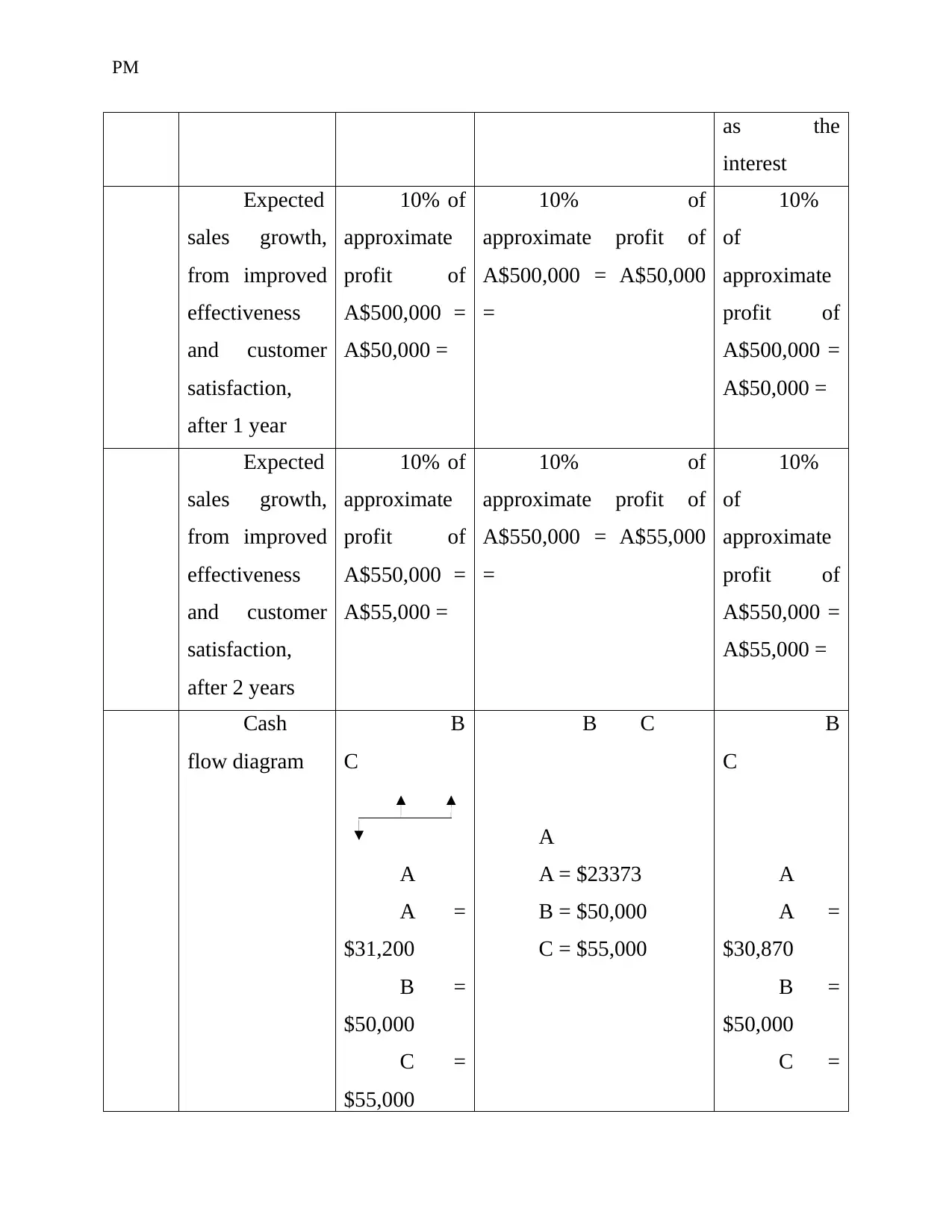
PM
as the
interest
Expected
sales growth,
from improved
effectiveness
and customer
satisfaction,
after 1 year
10% of
approximate
profit of
A$500,000 =
A$50,000 =
10% of
approximate profit of
A$500,000 = A$50,000
=
10%
of
approximate
profit of
A$500,000 =
A$50,000 =
Expected
sales growth,
from improved
effectiveness
and customer
satisfaction,
after 2 years
10% of
approximate
profit of
A$550,000 =
A$55,000 =
10% of
approximate profit of
A$550,000 = A$55,000
=
10%
of
approximate
profit of
A$550,000 =
A$55,000 =
Cash
flow diagram
B
C
A
A =
$31,200
B =
$50,000
C =
$55,000
B C
A
A = $23373
B = $50,000
C = $55,000
B
C
A
A =
$30,870
B =
$50,000
C =
as the
interest
Expected
sales growth,
from improved
effectiveness
and customer
satisfaction,
after 1 year
10% of
approximate
profit of
A$500,000 =
A$50,000 =
10% of
approximate profit of
A$500,000 = A$50,000
=
10%
of
approximate
profit of
A$500,000 =
A$50,000 =
Expected
sales growth,
from improved
effectiveness
and customer
satisfaction,
after 2 years
10% of
approximate
profit of
A$550,000 =
A$55,000 =
10% of
approximate profit of
A$550,000 = A$55,000
=
10%
of
approximate
profit of
A$550,000 =
A$55,000 =
Cash
flow diagram
B
C
A
A =
$31,200
B =
$50,000
C =
$55,000
B C
A
A = $23373
B = $50,000
C = $55,000
B
C
A
A =
$30,870
B =
$50,000
C =
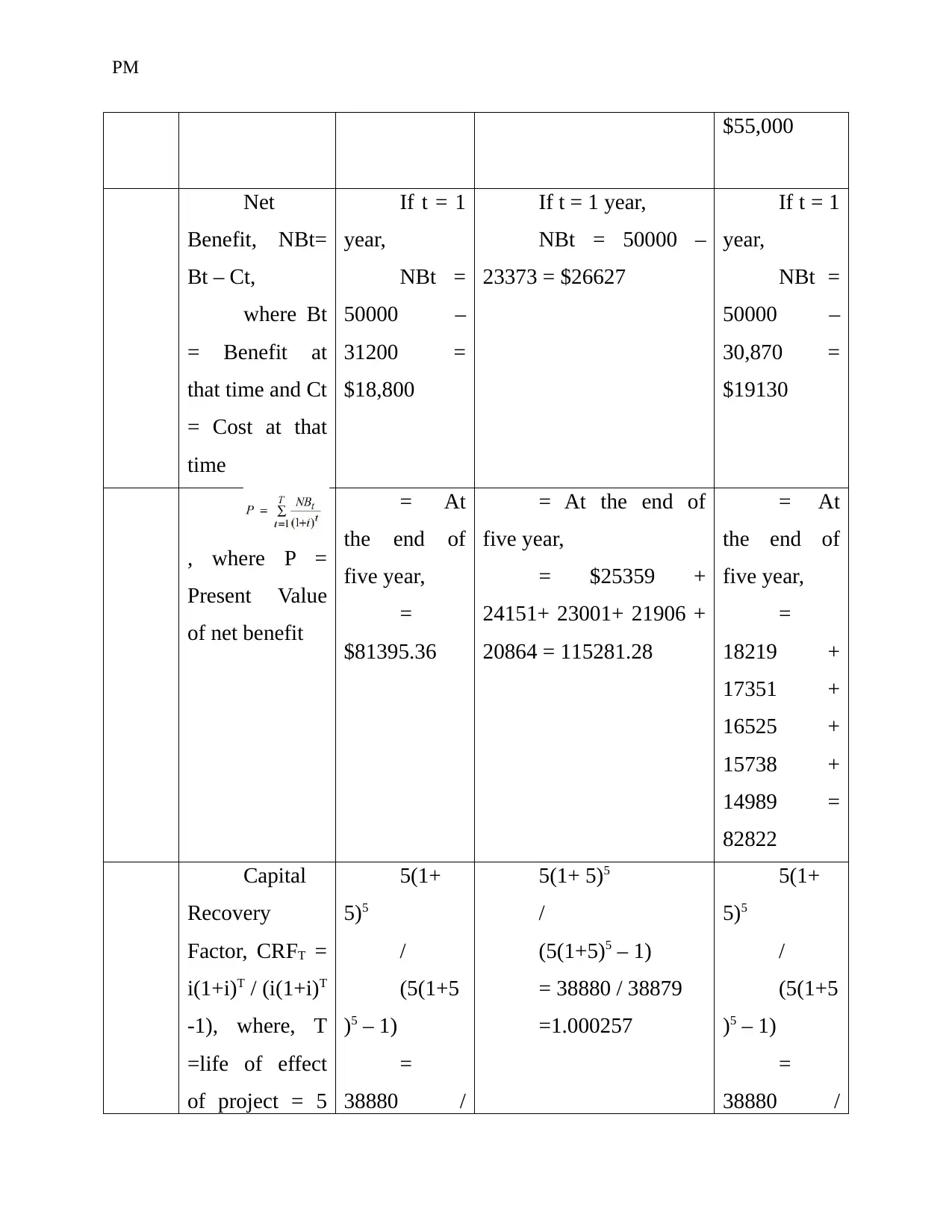
PM
$55,000
Net
Benefit, NBt=
Bt – Ct,
where Bt
= Benefit at
that time and Ct
= Cost at that
time
If t = 1
year,
NBt =
50000 –
31200 =
$18,800
If t = 1 year,
NBt = 50000 –
23373 = $26627
If t = 1
year,
NBt =
50000 –
30,870 =
$19130
, where P =
Present Value
of net benefit
= At
the end of
five year,
=
$81395.36
= At the end of
five year,
= $25359 +
24151+ 23001+ 21906 +
20864 = 115281.28
= At
the end of
five year,
=
18219 +
17351 +
16525 +
15738 +
14989 =
82822
Capital
Recovery
Factor, CRFT =
i(1+i)T / (i(1+i)T
-1), where, T
=life of effect
of project = 5
5(1+
5)5
/
(5(1+5
)5 – 1)
=
38880 /
5(1+ 5)5
/
(5(1+5)5 – 1)
= 38880 / 38879
=1.000257
5(1+
5)5
/
(5(1+5
)5 – 1)
=
38880 /
$55,000
Net
Benefit, NBt=
Bt – Ct,
where Bt
= Benefit at
that time and Ct
= Cost at that
time
If t = 1
year,
NBt =
50000 –
31200 =
$18,800
If t = 1 year,
NBt = 50000 –
23373 = $26627
If t = 1
year,
NBt =
50000 –
30,870 =
$19130
, where P =
Present Value
of net benefit
= At
the end of
five year,
=
$81395.36
= At the end of
five year,
= $25359 +
24151+ 23001+ 21906 +
20864 = 115281.28
= At
the end of
five year,
=
18219 +
17351 +
16525 +
15738 +
14989 =
82822
Capital
Recovery
Factor, CRFT =
i(1+i)T / (i(1+i)T
-1), where, T
=life of effect
of project = 5
5(1+
5)5
/
(5(1+5
)5 – 1)
=
38880 /
5(1+ 5)5
/
(5(1+5)5 – 1)
= 38880 / 38879
=1.000257
5(1+
5)5
/
(5(1+5
)5 – 1)
=
38880 /
Paraphrase This Document
Need a fresh take? Get an instant paraphrase of this document with our AI Paraphraser
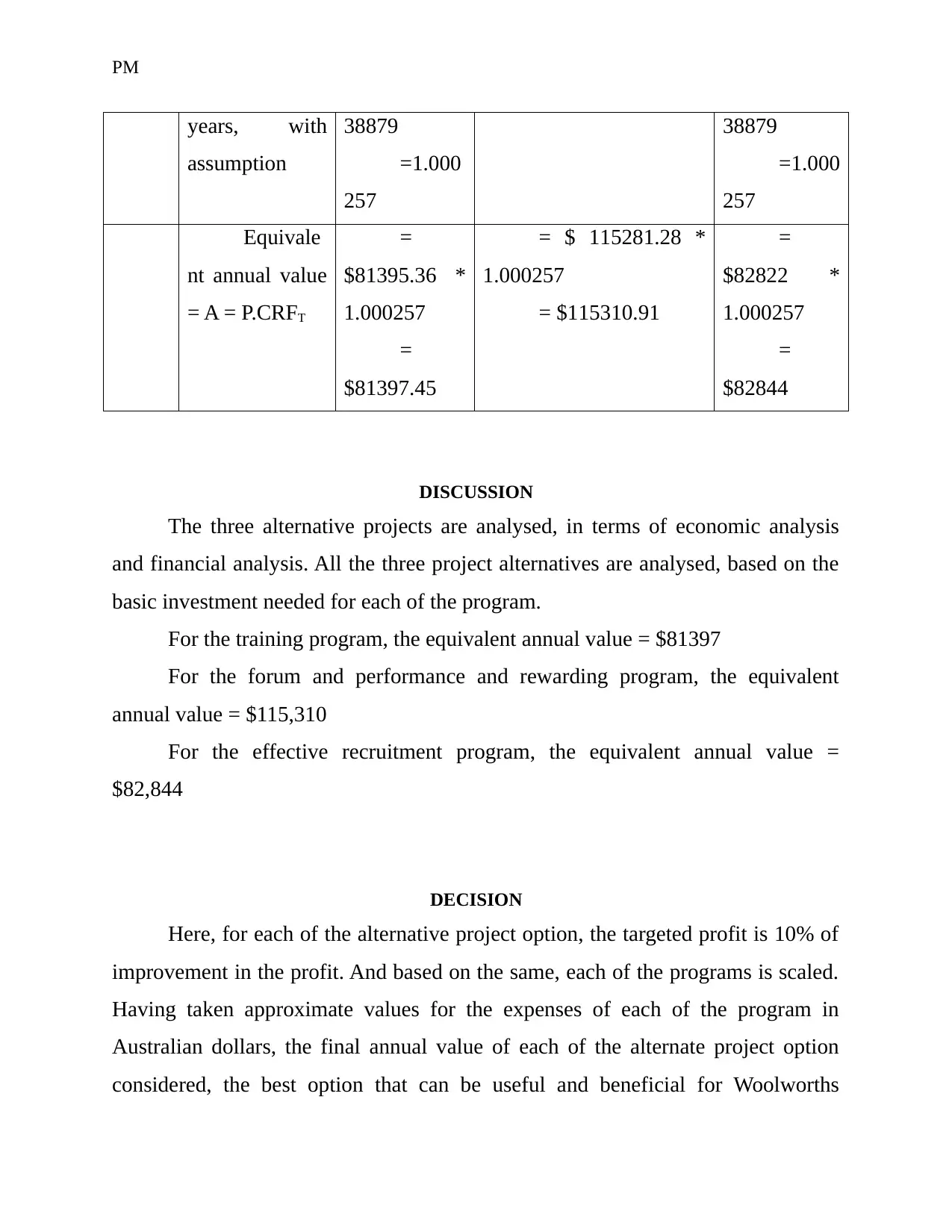
PM
years, with
assumption
38879
=1.000
257
38879
=1.000
257
Equivale
nt annual value
= A = P.CRFT
=
$81395.36 *
1.000257
=
$81397.45
= $ 115281.28 *
1.000257
= $115310.91
=
$82822 *
1.000257
=
$82844
DISCUSSION
The three alternative projects are analysed, in terms of economic analysis
and financial analysis. All the three project alternatives are analysed, based on the
basic investment needed for each of the program.
For the training program, the equivalent annual value = $81397
For the forum and performance and rewarding program, the equivalent
annual value = $115,310
For the effective recruitment program, the equivalent annual value =
$82,844
DECISION
Here, for each of the alternative project option, the targeted profit is 10% of
improvement in the profit. And based on the same, each of the programs is scaled.
Having taken approximate values for the expenses of each of the program in
Australian dollars, the final annual value of each of the alternate project option
considered, the best option that can be useful and beneficial for Woolworths
years, with
assumption
38879
=1.000
257
38879
=1.000
257
Equivale
nt annual value
= A = P.CRFT
=
$81395.36 *
1.000257
=
$81397.45
= $ 115281.28 *
1.000257
= $115310.91
=
$82822 *
1.000257
=
$82844
DISCUSSION
The three alternative projects are analysed, in terms of economic analysis
and financial analysis. All the three project alternatives are analysed, based on the
basic investment needed for each of the program.
For the training program, the equivalent annual value = $81397
For the forum and performance and rewarding program, the equivalent
annual value = $115,310
For the effective recruitment program, the equivalent annual value =
$82,844
DECISION
Here, for each of the alternative project option, the targeted profit is 10% of
improvement in the profit. And based on the same, each of the programs is scaled.
Having taken approximate values for the expenses of each of the program in
Australian dollars, the final annual value of each of the alternate project option
considered, the best option that can be useful and beneficial for Woolworths
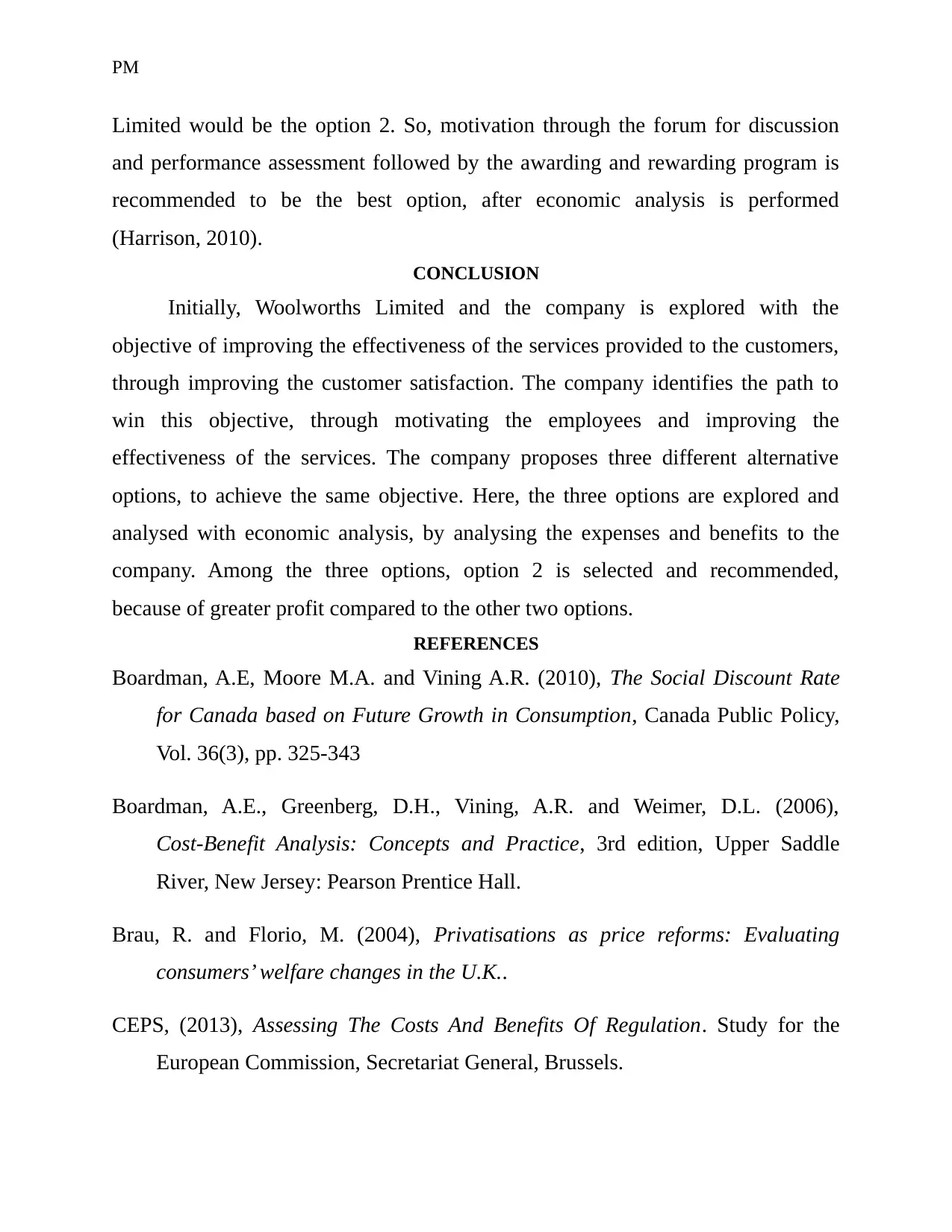
PM
Limited would be the option 2. So, motivation through the forum for discussion
and performance assessment followed by the awarding and rewarding program is
recommended to be the best option, after economic analysis is performed
(Harrison, 2010).
CONCLUSION
Initially, Woolworths Limited and the company is explored with the
objective of improving the effectiveness of the services provided to the customers,
through improving the customer satisfaction. The company identifies the path to
win this objective, through motivating the employees and improving the
effectiveness of the services. The company proposes three different alternative
options, to achieve the same objective. Here, the three options are explored and
analysed with economic analysis, by analysing the expenses and benefits to the
company. Among the three options, option 2 is selected and recommended,
because of greater profit compared to the other two options.
REFERENCES
Boardman, A.E, Moore M.A. and Vining A.R. (2010), The Social Discount Rate
for Canada based on Future Growth in Consumption, Canada Public Policy,
Vol. 36(3), pp. 325-343
Boardman, A.E., Greenberg, D.H., Vining, A.R. and Weimer, D.L. (2006),
Cost-Benefit Analysis: Concepts and Practice, 3rd edition, Upper Saddle
River, New Jersey: Pearson Prentice Hall.
Brau, R. and Florio, M. (2004), Privatisations as price reforms: Evaluating
consumers’ welfare changes in the U.K..
CEPS, (2013), Assessing The Costs And Benefits Of Regulation. Study for the
European Commission, Secretariat General, Brussels.
Limited would be the option 2. So, motivation through the forum for discussion
and performance assessment followed by the awarding and rewarding program is
recommended to be the best option, after economic analysis is performed
(Harrison, 2010).
CONCLUSION
Initially, Woolworths Limited and the company is explored with the
objective of improving the effectiveness of the services provided to the customers,
through improving the customer satisfaction. The company identifies the path to
win this objective, through motivating the employees and improving the
effectiveness of the services. The company proposes three different alternative
options, to achieve the same objective. Here, the three options are explored and
analysed with economic analysis, by analysing the expenses and benefits to the
company. Among the three options, option 2 is selected and recommended,
because of greater profit compared to the other two options.
REFERENCES
Boardman, A.E, Moore M.A. and Vining A.R. (2010), The Social Discount Rate
for Canada based on Future Growth in Consumption, Canada Public Policy,
Vol. 36(3), pp. 325-343
Boardman, A.E., Greenberg, D.H., Vining, A.R. and Weimer, D.L. (2006),
Cost-Benefit Analysis: Concepts and Practice, 3rd edition, Upper Saddle
River, New Jersey: Pearson Prentice Hall.
Brau, R. and Florio, M. (2004), Privatisations as price reforms: Evaluating
consumers’ welfare changes in the U.K..
CEPS, (2013), Assessing The Costs And Benefits Of Regulation. Study for the
European Commission, Secretariat General, Brussels.
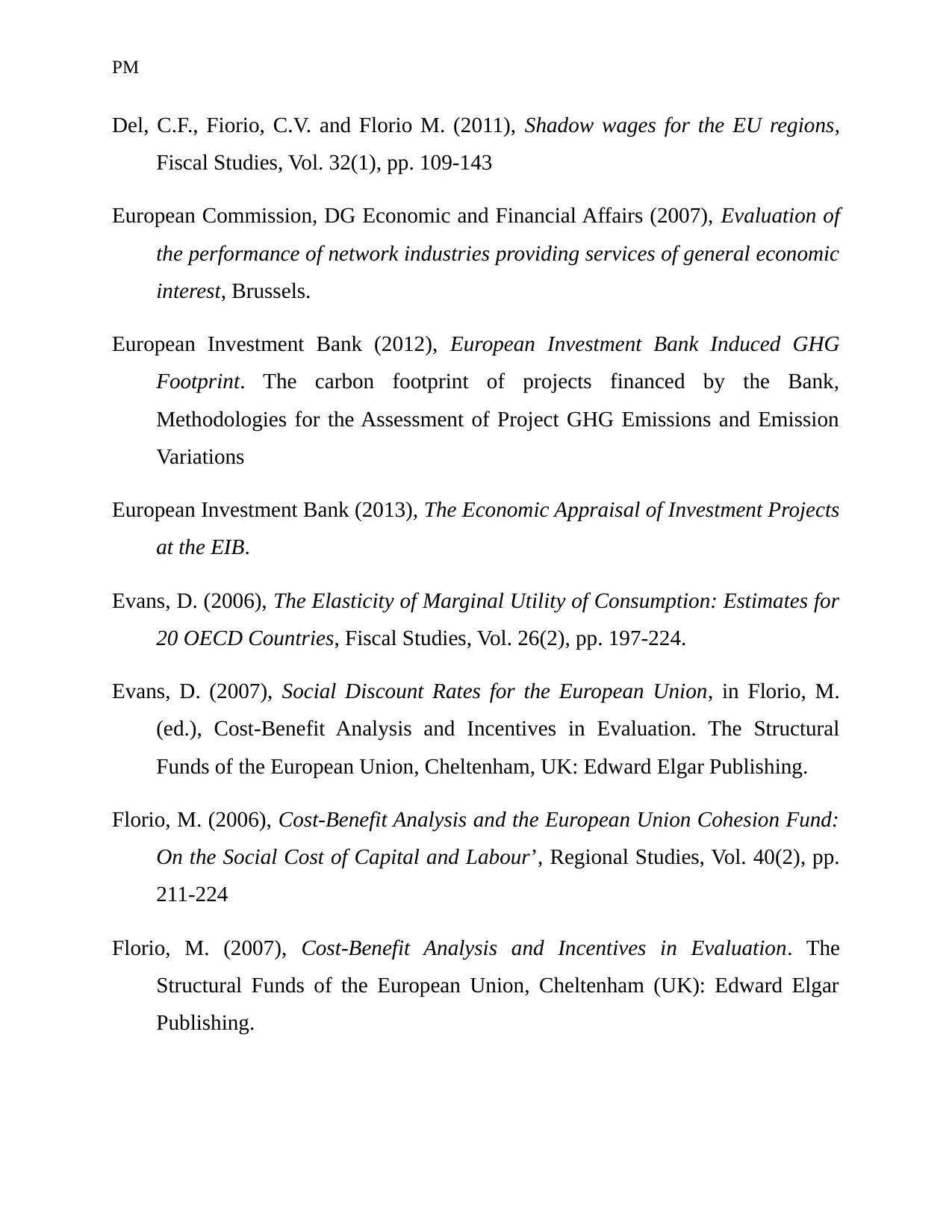
PM
Del, C.F., Fiorio, C.V. and Florio M. (2011), Shadow wages for the EU regions,
Fiscal Studies, Vol. 32(1), pp. 109-143
European Commission, DG Economic and Financial Affairs (2007), Evaluation of
the performance of network industries providing services of general economic
interest, Brussels.
European Investment Bank (2012), European Investment Bank Induced GHG
Footprint. The carbon footprint of projects financed by the Bank,
Methodologies for the Assessment of Project GHG Emissions and Emission
Variations
European Investment Bank (2013), The Economic Appraisal of Investment Projects
at the EIB.
Evans, D. (2006), The Elasticity of Marginal Utility of Consumption: Estimates for
20 OECD Countries, Fiscal Studies, Vol. 26(2), pp. 197-224.
Evans, D. (2007), Social Discount Rates for the European Union, in Florio, M.
(ed.), Cost-Benefit Analysis and Incentives in Evaluation. The Structural
Funds of the European Union, Cheltenham, UK: Edward Elgar Publishing.
Florio, M. (2006), Cost-Benefit Analysis and the European Union Cohesion Fund:
On the Social Cost of Capital and Labour’, Regional Studies, Vol. 40(2), pp.
211-224
Florio, M. (2007), Cost-Benefit Analysis and Incentives in Evaluation. The
Structural Funds of the European Union, Cheltenham (UK): Edward Elgar
Publishing.
Del, C.F., Fiorio, C.V. and Florio M. (2011), Shadow wages for the EU regions,
Fiscal Studies, Vol. 32(1), pp. 109-143
European Commission, DG Economic and Financial Affairs (2007), Evaluation of
the performance of network industries providing services of general economic
interest, Brussels.
European Investment Bank (2012), European Investment Bank Induced GHG
Footprint. The carbon footprint of projects financed by the Bank,
Methodologies for the Assessment of Project GHG Emissions and Emission
Variations
European Investment Bank (2013), The Economic Appraisal of Investment Projects
at the EIB.
Evans, D. (2006), The Elasticity of Marginal Utility of Consumption: Estimates for
20 OECD Countries, Fiscal Studies, Vol. 26(2), pp. 197-224.
Evans, D. (2007), Social Discount Rates for the European Union, in Florio, M.
(ed.), Cost-Benefit Analysis and Incentives in Evaluation. The Structural
Funds of the European Union, Cheltenham, UK: Edward Elgar Publishing.
Florio, M. (2006), Cost-Benefit Analysis and the European Union Cohesion Fund:
On the Social Cost of Capital and Labour’, Regional Studies, Vol. 40(2), pp.
211-224
Florio, M. (2007), Cost-Benefit Analysis and Incentives in Evaluation. The
Structural Funds of the European Union, Cheltenham (UK): Edward Elgar
Publishing.
Secure Best Marks with AI Grader
Need help grading? Try our AI Grader for instant feedback on your assignments.
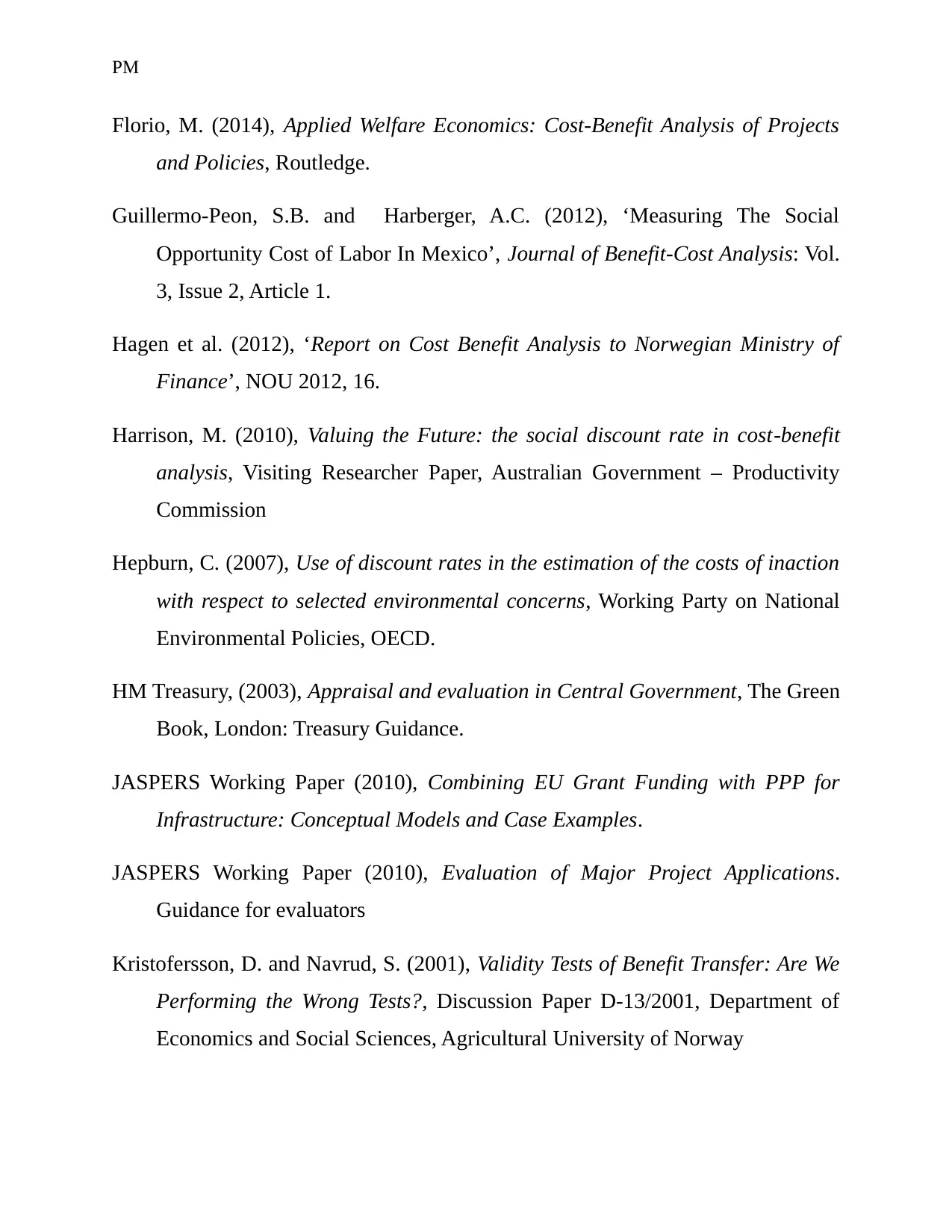
PM
Florio, M. (2014), Applied Welfare Economics: Cost-Benefit Analysis of Projects
and Policies, Routledge.
Guillermo-Peon, S.B. and Harberger, A.C. (2012), ‘Measuring The Social
Opportunity Cost of Labor In Mexico’, Journal of Benefit-Cost Analysis: Vol.
3, Issue 2, Article 1.
Hagen et al. (2012), ‘Report on Cost Benefit Analysis to Norwegian Ministry of
Finance’, NOU 2012, 16.
Harrison, M. (2010), Valuing the Future: the social discount rate in cost-benefit
analysis, Visiting Researcher Paper, Australian Government – Productivity
Commission
Hepburn, C. (2007), Use of discount rates in the estimation of the costs of inaction
with respect to selected environmental concerns, Working Party on National
Environmental Policies, OECD.
HM Treasury, (2003), Appraisal and evaluation in Central Government, The Green
Book, London: Treasury Guidance.
JASPERS Working Paper (2010), Combining EU Grant Funding with PPP for
Infrastructure: Conceptual Models and Case Examples.
JASPERS Working Paper (2010), Evaluation of Major Project Applications.
Guidance for evaluators
Kristofersson, D. and Navrud, S. (2001), Validity Tests of Benefit Transfer: Are We
Performing the Wrong Tests?, Discussion Paper D-13/2001, Department of
Economics and Social Sciences, Agricultural University of Norway
Florio, M. (2014), Applied Welfare Economics: Cost-Benefit Analysis of Projects
and Policies, Routledge.
Guillermo-Peon, S.B. and Harberger, A.C. (2012), ‘Measuring The Social
Opportunity Cost of Labor In Mexico’, Journal of Benefit-Cost Analysis: Vol.
3, Issue 2, Article 1.
Hagen et al. (2012), ‘Report on Cost Benefit Analysis to Norwegian Ministry of
Finance’, NOU 2012, 16.
Harrison, M. (2010), Valuing the Future: the social discount rate in cost-benefit
analysis, Visiting Researcher Paper, Australian Government – Productivity
Commission
Hepburn, C. (2007), Use of discount rates in the estimation of the costs of inaction
with respect to selected environmental concerns, Working Party on National
Environmental Policies, OECD.
HM Treasury, (2003), Appraisal and evaluation in Central Government, The Green
Book, London: Treasury Guidance.
JASPERS Working Paper (2010), Combining EU Grant Funding with PPP for
Infrastructure: Conceptual Models and Case Examples.
JASPERS Working Paper (2010), Evaluation of Major Project Applications.
Guidance for evaluators
Kristofersson, D. and Navrud, S. (2001), Validity Tests of Benefit Transfer: Are We
Performing the Wrong Tests?, Discussion Paper D-13/2001, Department of
Economics and Social Sciences, Agricultural University of Norway
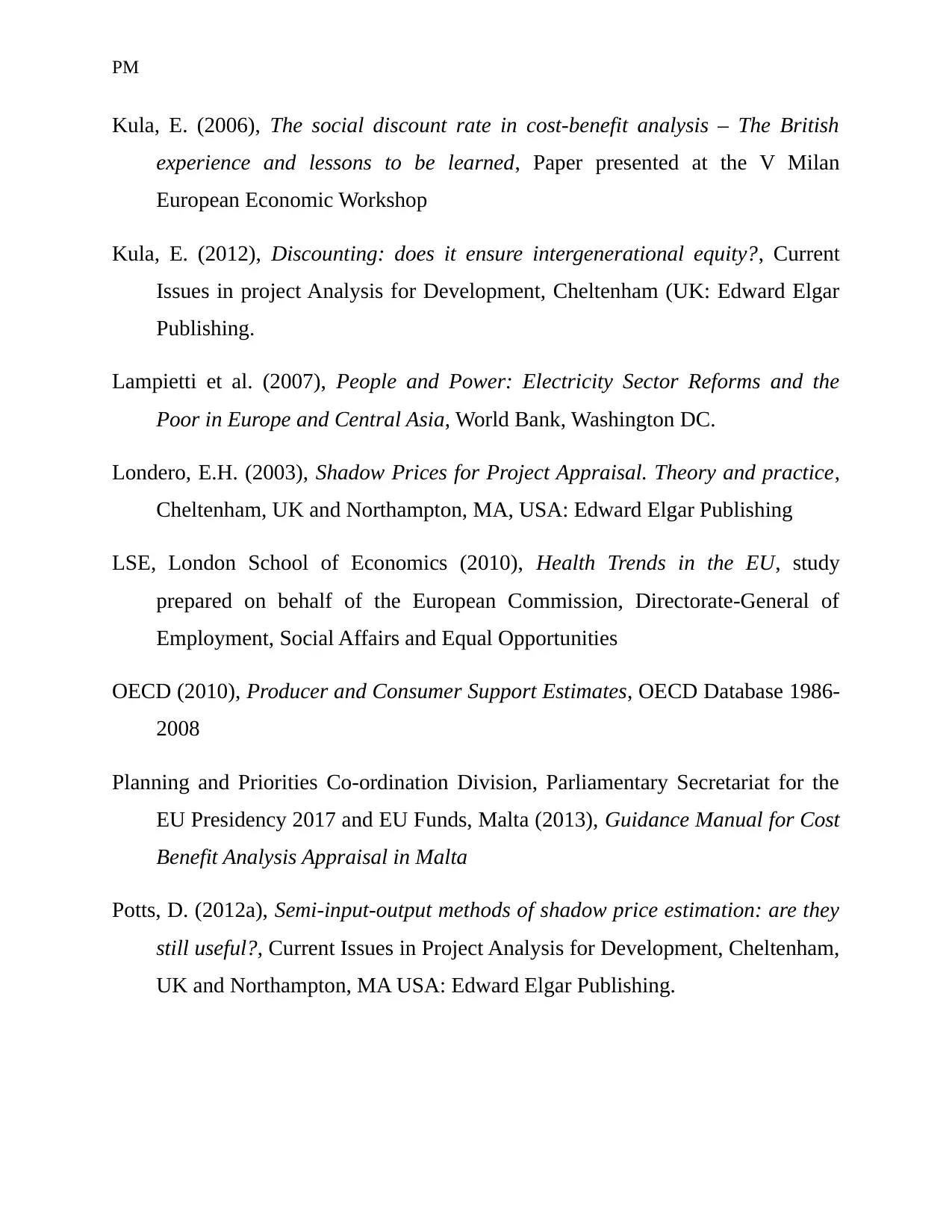
PM
Kula, E. (2006), The social discount rate in cost-benefit analysis – The British
experience and lessons to be learned, Paper presented at the V Milan
European Economic Workshop
Kula, E. (2012), Discounting: does it ensure intergenerational equity?, Current
Issues in project Analysis for Development, Cheltenham (UK: Edward Elgar
Publishing.
Lampietti et al. (2007), People and Power: Electricity Sector Reforms and the
Poor in Europe and Central Asia, World Bank, Washington DC.
Londero, E.H. (2003), Shadow Prices for Project Appraisal. Theory and practice,
Cheltenham, UK and Northampton, MA, USA: Edward Elgar Publishing
LSE, London School of Economics (2010), Health Trends in the EU, study
prepared on behalf of the European Commission, Directorate-General of
Employment, Social Affairs and Equal Opportunities
OECD (2010), Producer and Consumer Support Estimates, OECD Database 1986-
2008
Planning and Priorities Co-ordination Division, Parliamentary Secretariat for the
EU Presidency 2017 and EU Funds, Malta (2013), Guidance Manual for Cost
Benefit Analysis Appraisal in Malta
Potts, D. (2012a), Semi-input-output methods of shadow price estimation: are they
still useful?, Current Issues in Project Analysis for Development, Cheltenham,
UK and Northampton, MA USA: Edward Elgar Publishing.
Kula, E. (2006), The social discount rate in cost-benefit analysis – The British
experience and lessons to be learned, Paper presented at the V Milan
European Economic Workshop
Kula, E. (2012), Discounting: does it ensure intergenerational equity?, Current
Issues in project Analysis for Development, Cheltenham (UK: Edward Elgar
Publishing.
Lampietti et al. (2007), People and Power: Electricity Sector Reforms and the
Poor in Europe and Central Asia, World Bank, Washington DC.
Londero, E.H. (2003), Shadow Prices for Project Appraisal. Theory and practice,
Cheltenham, UK and Northampton, MA, USA: Edward Elgar Publishing
LSE, London School of Economics (2010), Health Trends in the EU, study
prepared on behalf of the European Commission, Directorate-General of
Employment, Social Affairs and Equal Opportunities
OECD (2010), Producer and Consumer Support Estimates, OECD Database 1986-
2008
Planning and Priorities Co-ordination Division, Parliamentary Secretariat for the
EU Presidency 2017 and EU Funds, Malta (2013), Guidance Manual for Cost
Benefit Analysis Appraisal in Malta
Potts, D. (2012a), Semi-input-output methods of shadow price estimation: are they
still useful?, Current Issues in Project Analysis for Development, Cheltenham,
UK and Northampton, MA USA: Edward Elgar Publishing.
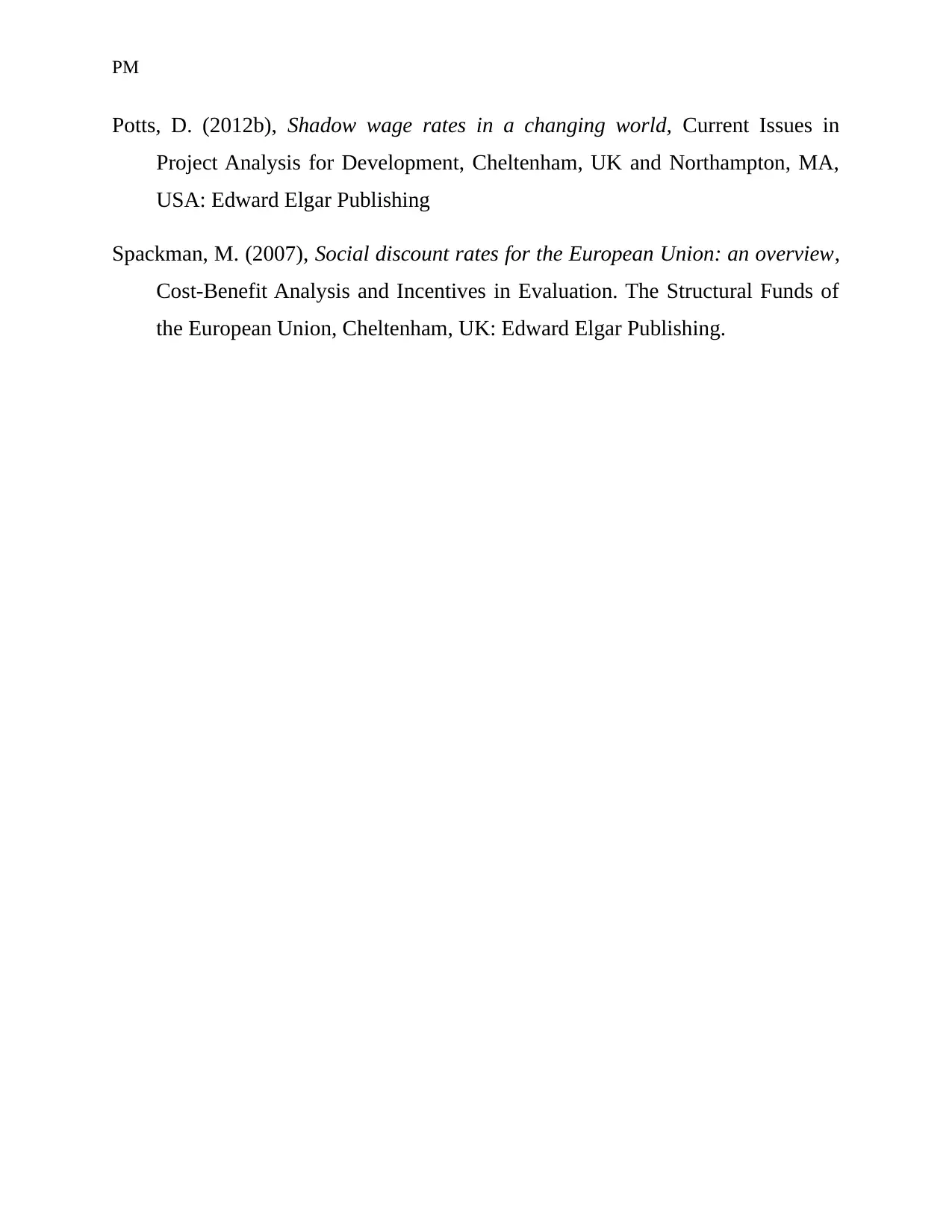
PM
Potts, D. (2012b), Shadow wage rates in a changing world, Current Issues in
Project Analysis for Development, Cheltenham, UK and Northampton, MA,
USA: Edward Elgar Publishing
Spackman, M. (2007), Social discount rates for the European Union: an overview,
Cost-Benefit Analysis and Incentives in Evaluation. The Structural Funds of
the European Union, Cheltenham, UK: Edward Elgar Publishing.
Potts, D. (2012b), Shadow wage rates in a changing world, Current Issues in
Project Analysis for Development, Cheltenham, UK and Northampton, MA,
USA: Edward Elgar Publishing
Spackman, M. (2007), Social discount rates for the European Union: an overview,
Cost-Benefit Analysis and Incentives in Evaluation. The Structural Funds of
the European Union, Cheltenham, UK: Edward Elgar Publishing.
1 out of 25
Related Documents
Your All-in-One AI-Powered Toolkit for Academic Success.
+13062052269
info@desklib.com
Available 24*7 on WhatsApp / Email
![[object Object]](/_next/static/media/star-bottom.7253800d.svg)
Unlock your academic potential
© 2024 | Zucol Services PVT LTD | All rights reserved.





